





























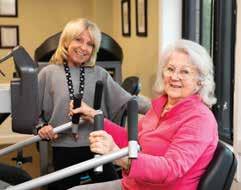
At Eddy Senior Living our priority is you. Participate in exercise classes, group outings, games, and clubs. Maintenance-free senior living gives you the time to engage in the activities you enjoy and allows you to continue with an active lifestyle.
Plus, our residents enjoy peace of mind knowing they have access to a continuum of care to meet their changing needs.
SIX EXCEPTIONAL COMMUNITIES LOCATED IN:
Niskayuna - Glen Eddy • Slingerlands - Beverwyck • Cohoes - Marjorie Doyle Rockwell Center • Troy - Beechwood at Eddy Memorial • East Greenbush - Eddy Hawthorne Ridge • Queensbury - The Glen at Hiland Meadows Contact us today to begin your new lifestyle! (518) 280-8385 | EddySeniorLiving.com

Experience all that Lake Placid has to offer with our “Buy 4, Get a 5th Night FREE” package. That’s right, stay 4 or more consecutive nights from now through December 19th and we’ll add a 5th night onto your stay for FREE! This popular package is sure to sell out, so call to book your reservations today!
518-523-2544

























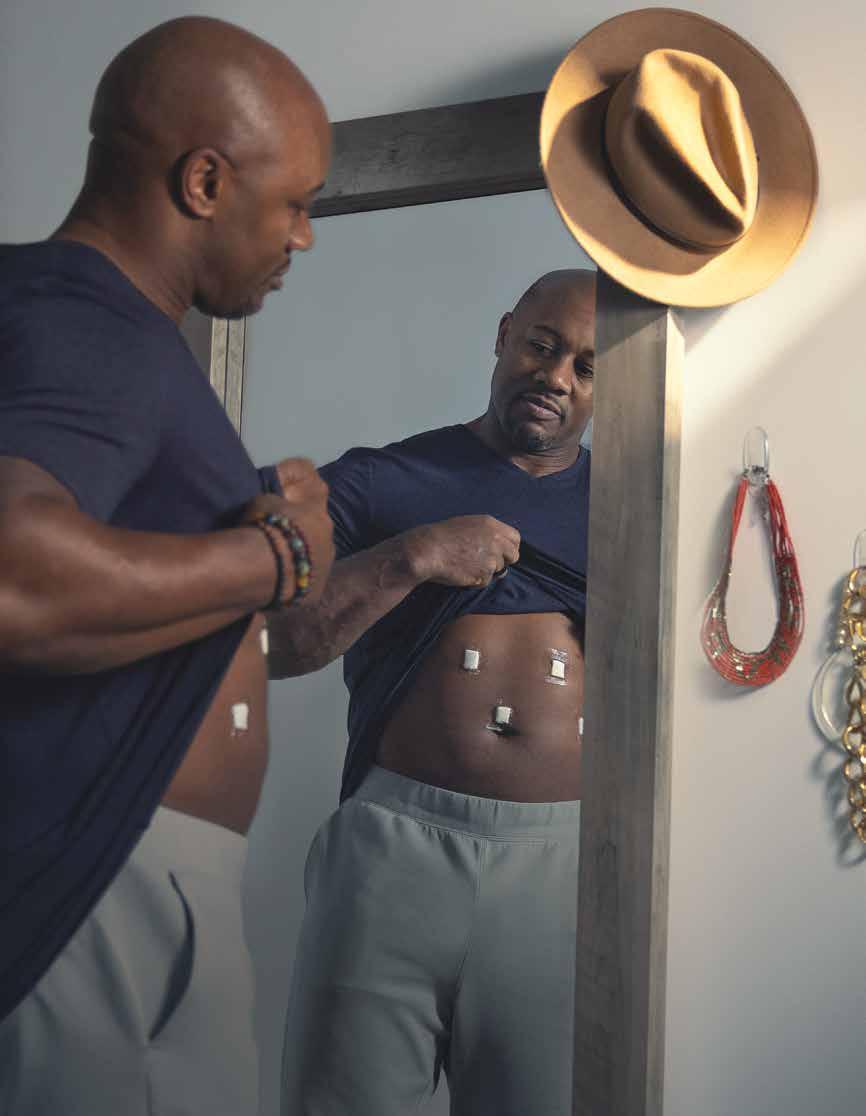



78 The World That Beer Built Age-old craft brewing tradition thrives in the Berkshires
85 New York’s Nuttiest Business Saratoga Peanut Butter Company spreads joy with every spoonful
35 Paul Grondahl: Master Storyteller
For decades he has been changing how Capital Region residents see their world
88 On Our Nightstand New books for inspiration
45 Brain Trust
One doctor’s toolkit for preventing — or even reversing — dementia decline
54 Don’t Worry! Do Nothing!
Sometimes just sitting back and being in the moment is exactly what we need to do


71 Closet Minimalist
The art of the capsule wardrobe
75 Farewell to the Family Home
A step-by-step plan for clearing out a lifetime of memories — and stuff
58 East of Eden
Expedition cruising unlocks the wonders of the enchanting, mysterious Galápagos
64 Country Roads
A Northerner’s guide to road-tripping on the Blue Ridge Parkway
16 Publisher’s Note
Alison Michael on the choices we make
53 Be Your Best Benita Zahn on embracing the seasons
90 The Vine Rod Michael on how to keep growing



Enjoy cottage living, designed for active, independent “55 and better” residents. Life at The Spinney is more than a great home...it’s a community of friends.
Single-story, maintenance-free living with attached garages, patios and decks. Coupled with our lifestyle programming, residents are able to connect through a wellness-focused lifestyle that empowers and inspires.
Pond View amenities include…
• Pet Friendly
• Dog Park
• Cable & Internet
• 24 Hour Maintenance
• Front & Back Porches
• Washer & Dryer in Unit
• Community Activities
Welcome home to Wellness. The Spinney at Pond View in Castleton pondviewleasing@livewellgroup.com | TheSpinneyatPondView.com
• Attached Garages
• Snow Removal
• Trash Removal
• Water Usage
• Community Gardens
• 5000 Sq Ft Clubhouse
• Pools





Publisher & Editor-in-Chief
Alison Michael | alison@55pluslifemag.com
Consulting Editor
Traci Neal
Marketing Consultant
Terri Jacobsen
Consulting Art Director
Tony Pallone
Design Consultant
Barb Dunn
Consulting Online Content Producer
Caitlin Manner
Contributing Writers
Tom and Jerry Caraccioli
Robin Catalano
Joanne Cleaver
Mary Ellen Fillo
Jennifer LaRue
Caitlin Manner
Rod Michael
Traci Neal
Janet Reynolds
Brianna Snyder
Benita Zahn
38

Pinnacle Living at Forts Ferry, conveniently located in Latham, NY, redefines luxury resort-style living for those 55+. Spend your days asking yourself “what do I want to do today?” rather than listing what you have to do. Pinnacle Living features award-winning lifestyle and social programming with our SUN Program® giving our residents all the excitement they crave paired with the privacy they deserve. If you’re ready to create the lifestyle of your dreams all you have to do is take the first step towards Pinnacle!


RESORT-INSPIRED AMENITIES
• Fitness studio & gym
• Community clubhouse
• Movie theater
• Library & lounge
• Community gardens
• Indoor pool & sauna
• 1 and 2 bedroom apartments
• Outdoor entertainment spaces with fire pits
• Continental breakfast 5 days per week

Now that I’m 58, my spouse and I often think about where we want to live as we get older. Currently, we live in a big 200-plus-year-old farmhouse which, while beautiful, is a lot of work, as you can imagine. We’re also parents of a 16-year-old and are riding that wave until he’s off to college.
Homeownership definitely equals maintenance. I don’t do much of it, as my husband will attest, but I do listen to him complain about it regularly: the shoveling and snow removal, mowing, weed-whacking, cleaning out the gutters, and so on. Don’t get me wrong, I love our home, but I can also imagine wanting something different, something new in our future. I’m not really sure what that something might be, but I do envision downsizing someday.

There are so many choices throughout this bucolic Capital Region, so that’s why 55+ Life is excited to bring you our first-ever Downsizing Open House Tour. Scheduled for Saturday, October 26, this is an opportunity to take a self-guided tour of some of the best homes the region has to offer — from multifamily and single-family houses, to new construction, to active adult communities, to a luxury multifamily rental community on Saratoga Lake. For details, look for our special pull-out Open House Tour Guide on page 59.
last holiday? I don’t. It’s not so much that we aren’t appreciative of gifts, it’s just that material things so often lack connection. This holiday, rather than giving “stuff,” I’m planning to give more experiential gifts — the types of gifts that create rich memories and bring more happiness. Experiences can get us and our gift recipients to try new things. Those are gifts worth giving. Our features, beginning on page 20, explain how and why experiential gifts should be on your shopping list this year.
Doing nothing, often leads to the very best something.
— Winnie-the-Pooh
Our story on page 54 about Olga Mecking’s book, Niksen: Embracing the Dutch Art of Doing Nothing, appeals to me in a way I wasn’t expecting. I feel like I’ve spent the past 58 years being busy — in part because I rarely sit still and in part because our culture says we need to always be doing something. I’d like to envision myself easing into my third act with a different mindset. With age, I’ve become more appreciative of the little things in life: a quiet space I give myself daily, a walk in nature, that soaking-upthe-sun feeling. n
As we move into the fall and toward winter, I’m already thinking about what to get people for the holidays. The angst of the season will soon be upon us. Isn’t it true that when we get to a certain age we really don’t need much? We’ve lived long enough to have everything we need and most of what we want. Do you even remember what you received or gave

alison@55pluslifemag.com





If you're seeking the peace and tranquility of small-town living without giving up life's conveniences, Juniper Ridge is the place for you. Centrally located in the historic Town of Halfmoon, Juniper Ridge offers a serene, countryside ambiance and is just minutes from great shopping, dining, and the Northway. Come experience the perfect blend of relaxation and accessibility at Juniper Ridge.
• Centrally located, 20 minutes from Albany & Saratoga Springs
• Shenendehowa Central Schools
• A short walk to Halfmoon Town Park
• Variety of floor plans (including ranch & primary down)
New Model Home/Sales Center
13 Silver Oak Drive, Halmoon, NY
Open Fri - Sat, 12p - 5p, Or by appointment
Contact Spencer Lewis: 518-512-9646 spencer@belmontebuilders.com www.belmontebuilders.com LIMITED TIME OFFER$5,000 off New Contracts









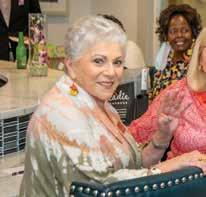
Carol Alexander
the alloro at university groves | thealloro.com
“For us, The Alloro isn’t just an apartment. The Alloro is a community of loving, supportive and caring neighbors, and a dedicated staff.”
Irene Teresi
arcadia gardens | arcadiagardensflorida.com
“I have been living at Arcadia Gardens for a year now, and I have to tell you how much fun it is. There are so many wonderful activities and events happening every day. Let the parties continue!”
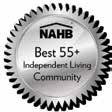
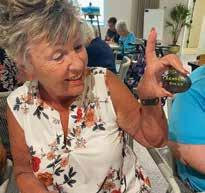

Barbara Harned
parasol melbourne | parasolmelbourne.com
“Since Parasol’s opening we have lived here and it has definitely been the best move we have ever made. It is like living in a luxury resort with all its amenities, such as heated pool, spa, exercise room and much more.”
Barbara Rosenzwig
the sovana at stuart | thesovana.com
“I have been living at Sovana since March ‘23 and I am very happy here. I love my apartment and the people who live and work here are all friendly and welcoming. The swimming area is wonderful and relaxing.”





Figuring out the perfect gift for someone can be stressful — even if you know them really well — and we all seem to have at least one person in our lives who is impossible to shop for. According to consumer experts, one trending solution is to give the gift of experiences. If you’re new to this idea, the premise is simple: Instead of purchasing a material object to give, you facilitate an experience for the recipient. Beth DuFault, consumerism expert and assistant professor of marketing at Pamplin School of Business at University of Portland, thinks this trend arose as a collective response to the frustrations of the pandemic. We were “isolated in our houses, and so more stuff is not necessarily something that we’re interested in,” she says. (Read more from DuFault in “Putting Fun Under the Tree” on page 30.)
There may also be an ecological motivation at play: Basically, experiences don’t end up in a landfill. Research also shows that giving experiences rather than things leads to more happiness and connection between the giver and the recipient.
To find out the best ways to give an experience, we spoke with Shannon Fromma, staff writer for the Times Union and creator of “The Shopportunist,” a biweekly column about frugal living. “What’s nice about experience gifts is you can really get creative and tailor
the experience to the person’s interests,” Fromma says. “There are a lot of great options around here, a lot of options that suit most budgets and age ranges.”
And if you’re worried that there’ll be nothing to unwrap, Fromma has an easy way around that dilemma. “My tip is to package the experience with something small. Like, if you’re giving a spa pass to your mom, you can wrap
a loofah bar and a nice shower gel, or something like that, just so there’s something tangible and you’re not just emailing the tickets to her.”
Some of Fromma’s experiential gift suggestions:
l LIVE NATION LAWNIE PASS: For $239 per pass, the recipient can attend every Live Nation Broadview Stage concert at the


Saratoga Performing Arts Center from the lawn. With over 25 concerts each season, that’s an amazing gift, and works out to about $10 per performance. Though 2024 sales have ended, passes for next summer will likely be available in February.
l SKI PASS PACKAGES: The SKI3 Season Pass provides passholders

BY CAITLIN MANNER
with lift access without reservations at Gore, Whiteface and Belleayre mountains, plus other perks including discounts on food and retail purchases and repair and tuning services, free scenic gondola rides, summertime price cuts and more. Passes start at around $550 with significant discounts for young children and people over 70.


l THE EMPIRE PASS grants free access to New York’s state parks for a whole year starting at $80. It’s also shareable among households.
l REGAL UNLIMITED is a subscription pass for movie buffs. It starts at $18.99 per month and provides entry into hundreds of Regal theaters, plus concession discounts and other perks.
You might be thinking that these suggestions are on the expensive side, but they don’t need to be extravagant to be impactful. Experience gifts can be something as simple as a cooking class, a wine tasting, a local food tour, a single theater performance, a museum membership, concert tickets … anything you think the gift recipient would enjoy.
Caroline Barrett, who runs Capital Cooks in Colonie with her husband Paul, says many of their students were given gift certificates for their cooking classes. “Some people buy classes for people who are newly married, for example, or just graduated,” she says. “But most often, it’s women who have bought a class for their husband, or were given classes and got their husband to come.”
For Barrett, the benefits of gifting someone a cooking class experience are threefold: “People are learning together, eating together and talking together,” she says. “They’re getting these great experiences from these talented chefs, but they’re also building community and enjoying time spent with other people.” n
Saratoga Springs couple steps up to give businesses a helping hand up
BY MARY ELLEN FILLO PHOTOS COURTESY OF BUSINESS FOR GOOD
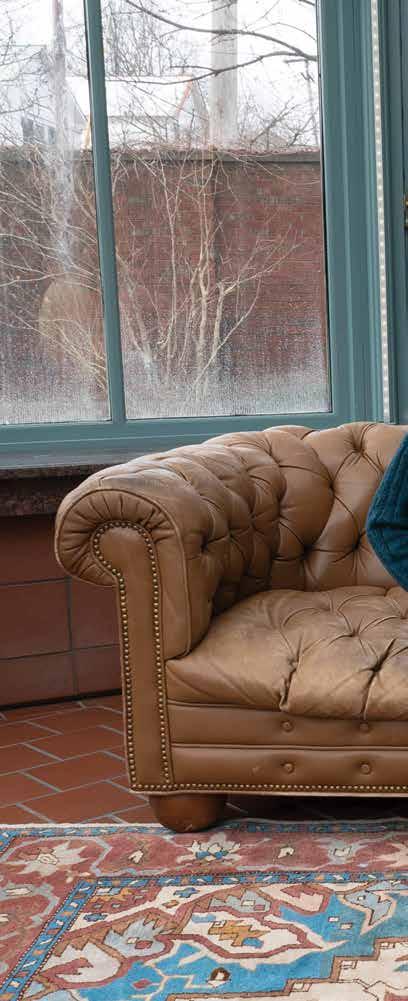


Ed Mitzen doesn’t recall when he first got into philanthropy, but he says his mother told him it was when he was 5 years old and he went trick-or-treating for UNICEF at Halloween.
Now in his mid-50s, Mitzen has ratcheted up that giving spirit, but in a way that does far more than throw out a temporary lifeline. Instead, his “intentional philanthropy” enables people to build better businesses, stronger communities and a more equitable world.
Mitzen and his wife, Lisa, are co-founders of Business for Good, a Capital Region nonprofit with a simple but life-changing mission: to put resources of all kinds into the hands of people who are in turn creating positive change in their own neighborhoods, particularly in underserved areas.
“I think it is human nature in all of us to see color, demographics, poverty and race,” said Mitzen, a successful business owner, author and award-winning philanthropist. “But Lisa and I see beyond that. We have both been blessed and we feel we are in a position that we can help those who just need a little extra juice to achieve their best success.”
Since 1995!






Garry J. Kearns, Executive Director
Columbia Crest ColumbiaCrest@ahfinc.net
90 One & Two Bedroom Apartments | Min. age requirement 60 Rent: 1 Bedroom $406–$880* | 2 Bedrooms $1010-$1180* 427 Columbia St., Cohoes, NY 12047 | (518) 235-4558
Highpointe HPAM@ahfinc.net
82 One & Two Bed Apartments | Min. age requirement 55 Rent: 1 Bedroom $594–$954* | 2 Bedrooms $1060* 30 Rockrose Way, Malta, NY 12020 | (518) 583-7977
Northern Pines NorthernPines@ahfinc.net
AND INCLUDE HEAT AND HOT WATER IN
36 One & Two Bedroom Apartments | Min. age requirement 55 Rent: 1 Bedroom $606–$747* | 2 Bedrooms $871* 120 Northern Pines Rd., Wilton, NY 12831 | (518) 581-8959
Van Allen VanAllen@ahfinc.net
110 One & Two Bedroom Apartments | Min. age requirement 55 Rent: 1 Bedroom $577—$889* | 2 Bedrooms $686—$1200* 790 Rte. 9W, Glenmont, NY 12077 | (518) 767-0923
Whitehall Court Whitehall@ahfinc.net
72 One & Two Bedroom Apartments | Min. age requirement 62 Rent: 1 Bedroom $685—$718* | 2 Bedrooms $837* 360 Whitehall Rd., Albany, NY 12208 | (518) 446-1920
Wilton Commons WiltonCommons@ahfinc.net
36 One & Two Bedroom Apartments | Min. age requirement 55 Rent: 1 Bedroom $598—$723* | 2 Bedrooms $855* 100 Wilton Commons Dr., Wilton, NY 12831 | (518) 581-7696 *Rents are based on income guidelines determined by the area’s median income.
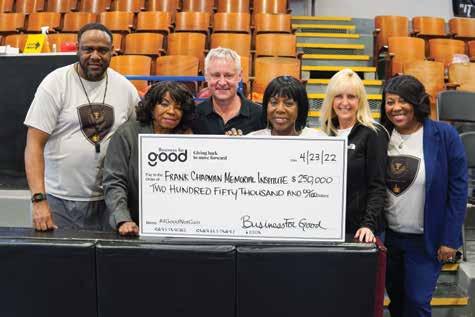

Business For Good began in 2020 when the Mitzens, concerned over the pandemic, the murder of George Floyd, growing racial unrest and the brightening spotlight on white privilege, decided to use their wealth to create a more even playing field for entrepreneurs. Already well-known philanthropists for dozens of causes, agencies and organizations, the couple decided Business for Good would be more than just a handout, it would be a hand up.
“We saw so many minority-owned businesses that just needed some business help — mentoring to help them develop better business sense, and some financial help to grow their business,” said Mitzen. “We look for people who have proven ability, (who are) trying to do it but haven’t had the same opportunities that we have,” added Lisa. “That’s Business for Good.”
With its seemingly simple but sensible mission, those on the receiving end of such a helping hand have not only succeeded, but grown, bringing economic stability and opportunity to neighborhoods that might otherwise have been overlooked and underrated.
“Ed Mitzen is an angel that dropped into our center,” said Jamil Hood, who runs Hood’s House of Hoops at the Frank Chapman Memorial Institute in Albany’s West Hill neighborhood. Funding from Business for Good allowed for sorely needed electrical, plumbing and construction upgrades to the House of Hoops building, seed money for a vari-






•
•
•
• 9 Foot Ceilings, Fireplace and Patio
• Quartz and Stainless Steel
•
• Community Gardens
• Pet Friendly with Dog Park
“ They gave me confidence because they had confidence in me.”
— Kizzy Williams, Allie B’s Cozy Kitchen, Albany
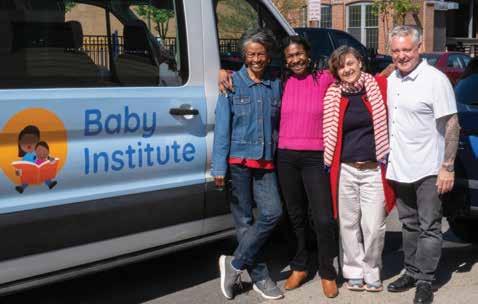
ety of programs, and the ability to provide a safe environment and necessary resources for families and youth in a distressed urban area.
“I remember when Ed first started coming around and I thought, ‘What’s this white dude walking around here?’” laughed Hood, recalling Mitzen’s first visits to the program.
“He is a remarkable guy with a heart of gold, and he understands, don’t be afraid of the ’hood,” Hood continued. “Besides what he brings in terms of money and support for businesses and centers like ours, he shows that you don’t see color, (you) see good people.”
“I think the Mitzens see that we work very hard to make a business work and they believe in us,” said Marie Chapman, who, with help from Business for Good, moved her business from a farmers market cart into a brick-and-mortar storefront that continues to grow as Blooms by Marie. “My grandmother was a nanny and worked for all the rich white people in Jamaica,” she explained. “Ed Mitzen invested in me. I think he looks at a business and sees that it is one that will thrive if he invests.”
The author of two books, More Than A Number: The Power of Empathy and Philanthropy in Driving Ad Agency Performance and Wealthy and White: Why Guys Like Me Have to Show Up, Step

At top, Ed Mitzen (right) and BFG continued their support for the Albany-based Baby Institute with the surprise arrival of a branded passenger van in 2023; above, Mitzen (center) attends the ribbon-cutting in 2023 for the new headquarters of the Albany Black Chamber of Commerce & Social Club in downtown Albany. BFG donated the space to help the organization better serve the community and grow over time.
Up, and Give Others a Hand Up, Mitzen also founded a series of successful advertising and marketing companies before starting Business for Good.
“We don’t see it as giving, but rather recognizing potential in business owners who just need a little more support, not just monetarily but academically, to make their businesses grow,” he said.
“I was lucky,” said Mitzen, who grad-
uated from Syracuse University and University of Rochester’s Simon Business School. “I had people in my life to reach out to — family and friends, people who knew how to incorporate a business, get business insurance, how to market and to develop a profit-and-loss statement. I was able to get an MBA degree,” he said. “Many of the people we have helped had no access
to mentors like I did, but are incredibly hardworking and passionate people, people who just did not have the opportunities others have.”
When it came to providing opportunity, Kizzy Williams, who owns Allie B’s Cozy Kitchen in Albany, has nothing but thanks and praise for the help she received from Business for Good — help that not only made her restaurant a very popular one, but also allowed her to do what she had always dreamed of doing.
“I grew up in Harlem and there was not a lot of opportunity for me. I went to school and took jobs, always just wanting to cook,” said Williams, who named her restaurant after her mother, Allie B. Bethea, a well-known area cook. Williams explained that when COVID hit, she feared for the future of her young business.
“They came into my life and provided the money I needed to get myself on my feet, to renovate the restaurant, and allowed me to open to the public once it was safe,” said Williams, who is also known for her own altruistic efforts on behalf of those in the West Hill neighborhood.
She’s since opened Allie B’s Fresh Fruits and Vegetables and Allie B’s Mac & Cheese, two newer businesses that were started with help from Business for Good. “They gave me confidence because they had confidence in me,” she said, noting the Mitzens are regular restaurant guests (Ed’s a fan of her pork ribs and Lisa loves her collard greens). “I was a girl born in Harlem with a mother from South Carolina who picked cotton,” she said. “The Mitzens see us as their babies, I think. And they grow us into successful adults.”
At a time when many people are thinking ahead to retirement, Mitzen teases that he doesn’t see he and Lisa ever giving up their mission.
“We have met amazing people along the way and built relationships with communities where they didn’t exist before,” said Mitzen, who estimates he and Lisa have helped hundreds of businesses and programs over the years. “This has been a real privilege for us to make new friends and help people realize their dreams and goals. We have gotten so much more out of our Business for Good efforts, much more than we have given.” n

By Ed Mitzen

1. You can’t lose weight while eating carbs.
2. Carbs cause fat gain.
3. All carbs are created equal.
4. Carbs aren’t good for your health.
5. There’s too much sugar in carbs.
Minimally processed carbs rich in fiber like whole grains and legumes offer a blend of sustained energy and essential nutrients.
Balancing carb intake with protein and fats and total calories supports overall dietary harmony.
Your unique biology, activity level, preferences, and goals influence your carb intake for optimal well-being.
Minimally processed fibrous carbohydrates increase satiety and help maintain steady blood sugar levels and a healthy body composition.
Different sugar structures—as well as the food source they come from—can have an effect on your perceptions of texture and sweetness and enzymes in your mouth and digestive system.
A good general guideline is for carb intake to represent about 35 to 50 percent of your daily calories. (If you’re eating a 2,000-calorie diet, this translates to about 175-250 grams of carbs). The minimum recommended intake for fiber is 25 grams per day. The optimal amount is around 35 grams/day for women and 48 grams/day for men.

BY CAITLIN MANNER
My son and I share a nerdy fondness for the NPR game show, “Wait Wait … Don’t Tell Me!” Every weekend we try to find the time to listen to Peter Sagal and his rotating panel of comedians as they make quips about current events and gleefully revel in clever puns. So when his birthday rolled around last year, instead of buying the latest gadget coveted by kids his age I got us tickets to the Wait Wait Stand-Up Tour. What I didn’t know at the time was that the live show would be vastly different from what we hear on NPR. The comedians were familiar, but the material wasn’t; there were more swear words than witty wordplay getting delivered from the stage, and the subject matter was decidedly more

mature. It was funny, to be sure, but inwardly I was cringing. This experience wasn’t going to be the memorable gift I had planned, I thought.
I was mistaken … again. Although the show wasn’t what we expected, my son still cites that outing as one of his alltime favorite moments with me. The other material gifts that he received from me are still getting some use a year later, but as it turns out, even an experience-gone-wrong bestows a more lasting positive impact.
As we settle into fall and start thinking about the upcoming holidays — and the vacuous labor of holiday shopping — consider the benefits of gifting experiences, like a cooking class, a show or a mani-pedi, rather than gifting “stuff.”

“When people have an experience, it becomes part of their identity.”
— Beth DuFault, consumer behavior scholar
What was revelatory to me — that gifting experiences could carry so many benefits — is actually a familiar phenomenon to experts in the consumerism field. A 2016 study in the Journal of Consumer Research found that experiential gifts foster stronger relationships than material gifts.
“Experiments examining actual gift exchanges in real-life relationships reveal that experiential gifts produce greater improvements in relationship strength than material gifts, regardless of whether the gift-giver and recipient consume the gift together,” the study authors, Cindy Chan, an assistant professor at the University of Toronto, and Cassie Mogilner, an associate professor at UCLA, noted. “The relationship improvements that recipients derive from experiential gifts stem from the intensity of emotion that is evoked when they consume the gifts, rather than when the gifts are received.”
In other words, experiential gifts carry significantly more emotional weight, and foster a closer connection between the recipient and gift-giver. We spoke with consumer behavior scholar Beth DuFault, assistant professor of marketing at Pamplin School of Business at University of Portland, to dive a little deeper.
“One of the reasons we exchange gifts is to cultivate personal relationships,” says DuFault. “And everything around the gift exchange, like the context, the meanings of things, the emotions, they lead to different relational outcomes.”
What researchers have found, DuFault explains, is that there is essentially a personal baseline of emotions you might experience when you receive a gift; you will feel roughly the same intensity of emotion regardless of whether the gift is material or experiential. But with experiential gifts, you will go on to create memories and attach stronger emotions to the experience itself, and therefore feel more closely connected with the gift-giver.

One of the key things for DuFault, when it comes to gift giving, is how this strengthening of relationships works.
The author gifted her son tickets to the “Wait Wait … Don’t Tell Me!” live comedy show — and it almost turned into a disaster. The birthday boy, however, still cites it as one of his favorite mother-son outings.
— Photo courtesy of Caitlin Manner
“Material things can be experienced and trigger memories, for sure. But they often don’t lead to the rich narrative-building that experiences do,” DuFault says. “When people have an experience, it becomes part of their identity construction. And our identities are narrative-based. So when you do the experience, and when you remember the experience later on, you are reliving the emotions, which is the thing that strengthened the relationship in the first place.”
The vast majority of gifts that people give are material gifts, says Hillary Wiener, assistant professor of marketing at the Massry School of Business at the University at Albany, adding, “They feel like a safer option.”
“The research basically shows that people are less certain [of success] when it comes to experiential gifts,” she says, “and they are very concerned about giving something that the person will not really like.”
One of the biggest concerns when it comes to experiential gifts is cost. You can give someone a trinket, for example, and if they don’t like it, the financial and emotional toll is relatively low. But experiences can cost more money (in general), and when you add the emotional aspect, the risk becomes much greater.

Keep in mind, Wiener says, that the concern over whether the recipient will like the experience is probably overwrought. “If you’re trying to think about it through the lens of, ‘well, I want to give them an experience but I’m not sure what it should be,’ know that [the recipient] might have a kind of default liking for the experience, even if it’s not necessarily the perfect thing, just because it is an experience rather than an item.” They may not get regular pedicures, for example, but might enjoy getting one as a gift because you gave it to them — or better yet, because you’re going along with them.
Additionally, even if the experience itself goes wrong, that doesn’t mean it won’t strengthen your relationship. DuFault fondly recalls a personal experience from years ago, when her first husband gifted her a ski trip. He was an avid skier, but she was new to the sport. In a scene right out of a romantic comedy, DuFault got stuck on the chairlift and had to get rescued by attendants to get down. “And I laughed so hard, and we just laughed so hard skiing down the hill, we fell into snow banks,” she recalls. “This was a huge relationship strengthening event at the time.”
Of course, the success of any experience depends on your shared interactions and perceptions. If one person is enjoying it and the other isn’t, that’s going to be an issue. But as long as the gift-giver is sensitive to the gift recipient’s emotional responses, any experience can have a positive impact … even bringing a preteen to an adult comedy show. n







By Janet Reynolds
This is precisely the kind of story Paul Grondahl would never suggest himself. Be the focus of a profile? Others are far more worthy. In fact, if you ask him, he’d likely have a few options.
That modesty is not surprising to those who know him. While Grondahl, a staff writer at the Times Union in Albany for 34 years before leaving in 2017 to become director of the New York State Writers Institute, has won enough state, regional and national awards to line a wall, he’s not that interested in being the star of a story. He’s far more interested in talking and listening to other people’s stories.
It’s that ability to draw people out that has helped make him such a trusted voice in the region. In an email, Rex Smith, former editor of the Times Union, writes of Grondahl’s strengths this way: “Journalism is more about reporting than writing, really, and while readers rightly appreciate the often-elegant prose of a Grondahl piece, Paul’s great capacity as a journalist arises from his broad curiosity and good heart, which combine to make his reporting powerful. That is, he seemed to delve deeper into relevant detail and weigh the human dimension of facts more thoughtfully than just about any reporter I’ve known. And then he would exquisitely fold in all those reported details as he wrote — which, by the way, produced such fine work that editing down a longer-than-expected Grondahl piece became nearly impossible.”
Smith recalls working with Grondahl when he was managing editor for news and Grondahl was working on an inves-


tigative piece about New York’s prison system, with a special focus on the toll solitary confinement took on prisoners with mental health issues. That series, Smith says, “required digging into corrections policies as well as winning the trust of deeply suspicious people who had been scarred by the system. Paul really listens to people, and that enabled him to produce a heart-wrenching but tough series.
“The caricature of a reporter as jaundiced and insensitive is sometimes deserved, but this guy defies the stereotype,” Smith concludes. “That is, Paul’s work is notable for its com-


passion. It always struck me that he was about the only reporter who people wished would call them.”
Grondahl never expected to be a journalist. The child of a mailman and a cashier at the local university bookstore in the state of Washington, he was the first in his family to get a college degree. The only books in his house, he says, were Reader’s Digest condensed versions or remainder books with their covers torn off that his mother had saved from the bookstore dumpster.
(Clockwise from top left) author and former fashion model Paulina Porizkova during a scholarship celebration at UAlbany, 2023; legendary filmmaker Francis Ford Coppola at The Egg in Albany, 2018; actress and UAlbany alum Awkwafina at the university, 2017; and actor Ryan Gosling at the 2012 Toronto Film Festival for the premiere of “The Place Beyond the Pines,” which was filmed in the Capital Region.
An English literature major, he put himself through the University of Puget Sound by writing sports copy for the local newspaper at night. He also worked on the campus newspaper. “The funny thing is, I’ve been a journalist for 40 years but never took a journalism class,” he says. “I was always an English literature major. I loved that you could read books and write about books and learn so many things by immersing yourself in great writing.”
The theater minor briefly contemplated postcollege life as an actor after working one summer at the Oregon Shakespeare Festival. “I could see I was not good enough to make it as an actor, so I began working on sets.”
But the experience heightened his appreciation for working in as part of a community, something Grondahl says he enjoyed as well during his years at the Times Union. “It was the daily miracle of putting this out,” he says, adding that he learned by doing.
Getting that first newspaper job did not come easily. Grondahl says he was initially rejected 200 times before being offered a night copy desk job in Juneau, Alaska. He was rejected by then-Times Union editor Harry Rosenfeld three times before finally landing a position on “night cops,” as they called the nighttime police beat, and that offer, Grondahl says, might have had more to do with his skills in softball than in journalism.
After getting a master’s degree in English literature at the University at Albany and doing a one-year fellowship in the
“ I’m just a conduit to let them tell their story.”
— Paul Grondahl

New York State Legislature — “I saw how the sausage was made,” he says — he finally got an interview. During the conversation, Rosenfeld asked Grondahl if he could play softball. “We need someone on second base,” he recalls Rosenfeld saying. He could, and he got the job.
Since then, Grondahl estimates he’s written about 10,000 stories of all lengths and complexities. During his Times Union tenure, he was sent to five continents for special stories.
Asked to name a few of the stories that still stick out for him, he recalls the series of stories he wrote after the September 11, 2001, terrorist attack in New York City. He had been taking the train to New York City to see the Tweed Courthouse renovation by John G. Waite Associates. The train stopped in Yonkers, where riders were informed that something was amiss and they could get a ride back to Albany from there. “Only a few stayed on,” Grondahl recalls.
After arriving in Penn Station, Grondahl began walking downtown toward the towers, armed with his camera and one roll of film. He had no cellphone. “The Number 7 building was still teetering and burning,” he says. “I got into
ankle-deep ash. Some firefighters were shell-shocked and I began interviewing. I finally got through to the City Desk, calling in my notes. I started to write the story in my head.”
Ultimately, Grondahl was at Ground Zero for seven days, phoning in a series of stories that helped the Capital Region learn firsthand what was going on.
Another series that still resonates for Grondahl is the story of Samuel “Poppy” Baez, a homeless man Grondahl first met when he took his daughter to work at a soup kitchen. Grondahl followed Poppy over the years, sometimes losing track of him. “He had moments of sobriety and clarity and a couple of apartments in [that time],” he says, noting Poppy was an incredible musician, playing harmonica and guitar. “He was my entrée into that world of street people, which can be violent and dangerous.” The series ended with Grondahl writing Poppy’s obituary.
And that’s just a sampling. The opioid crisis, a piece from 20 years ago about an athlete transitioning from male to female and more — Grondahl has been allowed into people’s lives in ways that many reporters never are.

Grondahl’s head shot from 1984, when he started as a police reporter on the night beat at the Times Union
q Times Union staff writer from 19842017; currently a weekly columnist
q Director of the New York State Writers Institute
q Book author of histories on Teddy Roosevelt during his Albany State Legislature years and Albany Mayor Erastus Corning 2nd, who was the nation’s longest-tenured mayor of an American city, among others
q Journalist mentor and freshman writing workshop teacher
q Multiple award-winning writer, including two national first-place wins and writing prizes from the Society for Features Journalists, more than a dozen New York State Associated Press writing awards and the Scripps Howard National Journalism Award


Promising compassion. Opportunities for creativity. Inclusive and diverse. Neighbors as Friends. Tradition of respect. Engaged, welcoming community. That’s the POINTE of it all.





CDPHP® Medicare Advantage plans come with one convenient prepaid Benefits Mastercard to use for dental and vision benefits.
† Our hours are 8 a.m. - 8 p.m. seven days a week from October 1 - March 31. From April 1 - September 30, Monday –Friday, our hours are 8 a.m. - 8 p.m. A voice messaging service is used weekends, after-hours, and federal holidays. Calls will be returned within one business day.
“You have to put yourself out there, too. You have to realize I’m a regular person too and just want to understand,” he says of his access. “The hardest thing to learn is it’s not about you.” Grondahl recalls advice he once heard Tracy Kidder give at a conference: Find a good story and get out of the way. “I’m still trying to get out of the way after 40 years. The best writing is where you don’t see the writer.”
After leaving the TU in 2017, Grondahl became director of the New York State Writers Institute. There, he has expanded the nonprofit’s presence in the state, adding annual book and film festivals and promoting the institute beyond the Capital Region.
Taking over the helm of the institute has brought Grondahl back to the beginning. It was Labor Day in 1981 when he first arrived at the University at Albany, which is home to the institute. The campus was fairly empty. “One door was open in the humanities building,” he says, “and one light.” The light was in the office of William Kennedy, the renowned Albany Pulitzer Prize-winning author of a series of novels about the town (Ironweed, Legs and others). Kennedy, who initially funded the institute with prize money, became Grondahl’s
And here’s Grondahl with...
(Clockwise from top right) authors
Alice McDermott and William Kennedy, following an on-campus reading at UAlbany in 2024; his wife Mary Grondahl, in Paris overlooking the Seine at sunset; freshmen UAlbany students in the writing workshop he co-teaches with English professor and poet Jil Hanifan, center back.
mentor and friend. “I’ve come full circle,” Grondahl says. “This is a dream job. I feel so lucky.”
And the region is lucky to have him in that position, says Joe Donahue, host of “The Roundtable” and “The Bookshow” on WAMC. “There is no one better to take over the reins. He understood the institute’s importance in the region and state.
“Paul is so inclusive,” he continues. “He’s so aware of the conversations that we need to have and are already having and that need to be put on the fast track.”
Although Grondahl turned 65 this year, he’s not interested in slowing down — yet. There are more students to teach, more programs to add to the institute and, of course, more stories to tell.
“I like to comfort the afflicted, afflict the comfortable,” Grondahl says, referencing a well-known journalistic aphorism. “It’s delicious to take down a hypocritical pompous person of influence, give them enough room to hang themselves.
“People joke that I’m always late because I stop people. They stop me,” he explains. “I never know what the story is going to be. I’m just a conduit to let them tell their story.” n
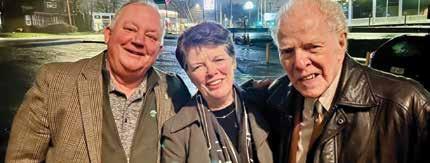

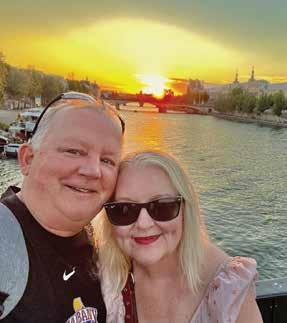

At Hudson Headwaters, our primary care providers are dedicated to meeting your specific health care needs, and keeping you in good health. We’re here for you—at every stage and every age.


By Daniela Andrade, LCSW-R Behavioral Health Provider, Hudson Headwaters
When we volunteer, we often think the people we help benefit the most. However, research shows that volunteering is great for volunteers too. Volunteering increases self-confidence, reduces loneliness and can lead to a more positive view of the world. The key, according to research, is that volunteers help a cause that is truly meaningful to them.
According to Harvard Medical School, volunteering really makes you feel good. This feeling is sometimes referred to as “the helper’s high” because your body releases endorphins when you experience an enjoyable volunteer role. Harvard calls these endorphins “the brain’s natural pain reliever.”
Volunteering can also lessen symptoms of depression, heart disease, high blood pressure and chronic pain.
Researchers from Carnegie Mellon University discovered that older adults who spend at least 200 hours per year volunteering are 40% less likely to develop high blood pressure than those who did not. In fact, during acts of kindness, our brains release a hormone called oxytocin, which reduces stress and can reduce blood pressure.
Knowing how impactful it can be, many organizations, including Hudson Headwaters, offer paid time off for staff to volunteer and give back to their communities.
“Many of our staff are drawn to the Network because they want to make an impact, so it makes sense to offer volunteer time off as a benefit,” explains Sue Corney, executive vice president human resources. “It’s truly a winwin situation for our staff and communities.” Reap the benefits of volunteering!
Reach out to your favorite nonprofit organization and ask about volunteer opportunities.
For more information on the research noted in this article, visit: cmu.edu/news/stories/archives/2013/june/june13_volunteeringhypertension.html hsph.harvard.edu/news/hsph-in-the-news/study-volunteering-is-good-for-your-health

Albany ENT and Allergy Services recently welcomed Dr. Robert Scagnelli to its team of physicians, bringing the total number of AENT clinicians to 35, including 18 physician assistants and seven licensed audiologists. He is the team’s 10th specialist.
Dr. Scagnelli earned his undergraduate degree at Siena College, and his medical degree from Albany Medical College. He served his internship and residency in Otolaryngology-Head and Neck Surgery at Albany Medical Center. His professional and personal interests include educating his patients, running, golfing, cooking, spending time with family, and remaining active in his community church parish.


“We’re delighted to welcome Dr. Scagnelli to the team,” noted Dr. Gavin Setzen, president and CEO of Albany ENT, “and are confident that his training and skills will allow us to serve the needs of even more of our neighbors in the Capital Region and beyond.”
Added Dr. Nora Perkins, AENT senior partner, “Rob’s devotion to his profession and our local community is exactly what our practice is all about. Welcome aboard!”
Dr. Scagnelli will see adult and pediatric patients in the practice’s current clinical locations on Everett Road and Clifton Park.
To learn more about Albany ENT & Allergy Services, the Capital Region’s largest private otolaryngology practice, or to schedule an appointment, call 518-701-2085 or visit albanyentandallergy.com.






















AOne doctor’s toolkit for preventing — or even reversing — dementia decline
sk just about any person of a certain age to name their greatest fear about growing older and many will likely say dementia. Indeed, a 2021 survey noted that 64 percent of Americans say getting dementia is their biggest anxiety around aging.
It’s a concern that isn’t unreasonable given the sobering statistics in America. The number of people in the U.S. with Alzheimer’s is expected to reach 8.5 million by 2030 and 11.2
BY JANET REYNOLDS
million by 2040, according to the Alzheimer’s Association. The trend, however, doesn’t have to continue, according to Dr. Heather Sandison, author of a new book called Reversing Alzheimer’s: The New Toolkit to Improve Cognition and Protect Brain Health (HarperCollins, 355 pages). Not only can people take action to help prevent future cognitive decline, but even those who already have symptoms and/or a dementia diagnosis can take steps to regain cognitive function. Alzhei-




































































mer’s does not, she says, have to be a death sentence.






Sandison, a naturopath doctor who’s dedicated her career to helping those with Alzheimer’s, is the founder of Solcere Health Clinic, which focuses solely on brain health, and Marama, the first residential care facility devoted to caring for the elderly using her immersive, whole-person strategies. She is also the primary clinical investigator and author of a peer-reviewed article on how lifestyle intervention can help people with cognitive decline.
Sandison outlines her strategy for dealing with dementia in her new book, which includes a plethora of scientific information and research to support her methods. The book takes a conversational tone as Sandison breaks down the various steps required to help reverse cognitive decline. She also includes chapters to help caregivers manage their own lives, as well.
“What I add is unique,” Sandison says in a phone interview. “I’ve had a lot of experience coaching people. My approach is very practical and compassionate. And I have seen over and over again that people can measurably improve their cognitive function.”
Her 2023 study is just one example. Of 23 participants, 17 of them experienced cognitive improvements in just six months. And they did this from their homes. In other words, not all of them necessarily implemented every single detail of her protocols, she notes in the book, and the study still had



a 75% success rate.



Sandison outlines six components that need to be analyzed and addressed for a brain to operate optimally:
• TOXINS: These can keep your brain in defense mode and move resources away from making new neurons that can in turn damage your brain.
• NUTRIENTS: What you eat matters to your brain health. Too many carbohydrates and sugar can damage the brain, for instance.
• STRESS: Both too much and too little stress can hurt brain health. Finding a happy medium is key.
• STRUCTURE: This includes your physical makeup and your genes. If you’re not getting enough oxygen when you sleep due to the shape of your airways, for instance, your brain can suffer.
• INFECTIONS: These can redirect resources from your brain and cause damage.
• SIGNALING: This refers to all of the body’s chemical messengers that interact with the brain, such as estrogen and testosterone, as well as proteins. Inadequacies in any area — hello, menopause — or receiving too much of a particular messenger can hurt brain health.
Sandison then outlines in clear, precise detail how to change your lifestyle to help all of those components work more optimally. She knows humans well enough to realize that tackling all her suggestions may feel overwhelming (or even impossible if your care partner, as she calls the person with cognitive issues, is less than cooperative or has trouble understanding the changes). Each section, then, has a suggestion in bold that explains one action to take if you feel you can only take one step. In a segment about eliminating toxins, for instance, her one-step advice to reduce toxic exposure is to take your shoes off at the door and open your doors and/or windows for an hour every day. Who can’t do that? (Sandison also includes video links after many of the chapters for those who want more information or who process information more easily that way.)
The best success, of course, involves implementing Sandison’s lifestyle strategies more completely. She devotes a chapter to each of the steps, from getting organized with daily routines to incorporating exercise and more. And the chapters offer readers multiple ways to begin to implement these changes. Making change one step at a time is perfectly fine if that’s where you are.
One of Sandison’s required strategies — and she cites plenty of research to back up her plan — is to eat a keto-
Dr. Sandison’s “one step can make a difference” advice:
• If you do one thing to take better care of your brain through diet, start by eating lower-carb alternatives to the foods you eat regularly. Instead of rice, try cauliflower rice or quinoa. If candy or sweets are your thing, try a chocolate bar that uses an allulose, monk fruit or sugar alcohol instead of regular sweeteners.
• If you do one thing to reduce stress, prioritize social time. “We are social animals,” she notes in the book. “We need connection to others. It doesn’t matter if your connection is with one or two people or a large group; it only matters that you spend time relating to others.”
• If you do one thing to address infections, brush and floss twice daily, no exceptions.
• If you do one thing to support your structures, see if you have sleep apnea and then follow whatever treatments are recommended.
• If you do one thing for signaling, exercise. “The key,” Sandison writes, “is to do more than whatever you have been doing.”
genic diet. Ketones, which are the fatty acids that the body creates when using fat rather than glucose, are the brain’s preferred food. Realizing that implementing a diet overhaul like this can feel overwhelming, she helpfully provides multiple recipes and a list of various foods in the different food categories needed to achieve ketosis (where your body burns fat for energy rather than glucose or sugar). Once people have achieved the results they desire — a higher cognitive score — they can ease back into incorporating the ketogenic diet periodically with their more “normal” eating patterns. The key is to continue to incorporate ketogenic eating regularly. You could eat a ketogenic diet a few days a week, for instance, or for a month at a time.
Overall, Sandison preaches connection over correction. “My experience has been that it’s not about changing someone’s mind. If we come in with that as our goal, you usually end up with conflict,” she says. “Getting curious is step one for engaging anyone if you’re trying to create behavior change.
“When you can shift that conversation day to day, you get to experience more of the joy,” she continues. “Growing old is a privilege that is denied to so many. When we can maintain that joy, that connection, that meaningful quality of life, that’s the joy of life.” n
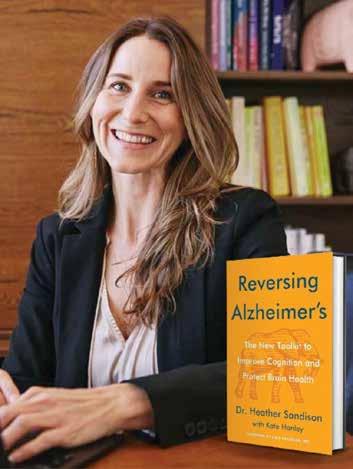

BY DAVID A. KUBIKIAN, ESQ. HERZOG LAW FIRM
WhenI meet with prospective clients who want to engage in estate or elder law planning, it is not uncommon to hear them forcefully tell me something along the lines of “I will never go to a nursing home” and/or hear them allude to preferring to take walk in the woods and “take matters into their own hands.” I understand what they are saying. It should be nobody’s life goal ever to call a skilled nursing facility their home. Nonetheless, we don’t always have choices in life and the truth is that with caring and compassionate skilled care, the quality of our life can greatly be enhanced, even in a nursing home. There is, however, an alternative called “aging in place.”
Aging in place is a relatively old concept which has gotten a new life in recent years, coinciding with the increase in the elderly population and the stigma of nursing homes. The idea is simple. Keep your loved one in their most familiar environment, their home, while balancing their needs for social interactions, rehab/ exercise and the type of care they require on a day-to-day basis. After all, if a loved one has dementia robbing them of their short-term memory, why not surround them with pictures and
furnishings that make them (hopefully) feel comfortable? Typically, aging in place requires not only a home that physically can accommodate a loved one (safety bars in bathrooms, larger hallways and doorways), but also someone ready, willing and able to provide the necessary care. That brings us to one of the most overlooked parties in the long term care planning equation: the caregiver.
A few years ago, The New York Times addressed the life of a caregiver in an article that told the heartbreaking but increasingly familiar story of Mark Donham, the husband and now widower of his wife, Chris. Mark’s wife had early-onset Alzheimer’s, and Mark stood by his wife’s side the entire time. As the article describes, Mark quit his job in order to take on the much harder job of being a 24-hour caregiver. Laundry, cleaning and later toileting, feeding and transporting were all part of his new job description. By all accounts, Mark did everything he could, until the disease took his wife. Along the way, his efforts had a negative impact on his life in more ways than just grief. The stresses of caring for his wife, whether financial, physical or emotional, took their toll. Know that help is out there.
When we do our educational Estate and Medicaid Planning seminars, it
is common for attendees to be hearing about “Community Medicaid” for the first time. A part of the federal Medicaid program, Community Medicaid is a vehicle through which people can get skilled nursing or home health aids in their own home. Community Medicaid can even include programs that get your loved one out of the house to get that valuable social contact. Similar to Medicaid coverage in nursing homes, Community Medicaid is a needs-based program, and an applicant must be below certain resource levels in order to qualify. Unlike nursing home care however, Community Medicaid does not have a five-year look back period — meaning that it is never too late to get help caring for your loved one at home. In addition, with proper counsel, you can use excess income for your expenses. This means getting Medicaid to pay for hours of care for your loved one while using that loved one’s excess income for either additional care or other expenses. Figuratively, this is like having your cake and eating it, too. Aging in place is a wonderful idea. Taking care of your loved one through their dementia is a good and noble thing. Doing it alone, however, is something you should try to avoid. Look into Community Medicaid for the sake of your loved one and yourself.
REGISTER TODAY TO SECURE YOUR SPOT
Make plans to attend one of our FREE seminars to get your Medicare questions answered and learn more about your coverage options.
Wednesday, Oct. 23 at 10:00am
7 Southwoods Boulevard, Albany
Wednesday, Nov. 6 at 10:00am
60 Railroad Place #302, Saratoga Springs
Hosted by Simplify Medicare and Herzog Law Firm
SPACE IS LIMITED!
Reserve your spot today at 55pluslifemag.com/medicare
By Tracey Kayo Twarog
The world of Medicare can be confusing and overwhelming. There’s so much information to sort through and understand. When there are new developments, it becomes even more overwhelming. The Medicare landscape is changing, and it is extremely important to be informed so you can make the best decision for your specific health care needs. Some of the biggest changes in the past few years are coming to Medicare in 2025.
Beginning in 2025, the Inflation Reduction Act will require all Medicare prescription drug plans to offer enrollees the option to pay out-of-pocket prescription drug costs in the form of capped monthly payments instead of all at once at the pharmacy. It benefits people with Medicare Part D by imposing a $2,000 cap on annual out-of-pocket prescription drug costs. Additionally, the Act extends certain provisions through 2025, including savings on health insurance premiums for millions of Americans. It also transitions tax credits for clean electricity projects.
There will be a shift in the structure of Medicare Part D.
• Drug manufacturers will have to pay more
• Part D plans will have to pay more
• Medicare beneficiaries’ (members’) drug costs will decrease
• Premium changes
• Updated copays on different tiers of drugs
• Drugs changing tiers or being removed from the plan’s formulary
Starting in 2025, Medicare Advantage plans will be required to send policyholders a personalized “Mid-Year Enrollee Notification of Unused Supplemental Benefits” in July. It will list all supplemental benefits the member hasn’t used, the scope and out-of-pocket cost for claiming each one, instructions on how to access the benefits, and a customer service number to call for more information.
In response to the growing need for mental health and substance use disorder treatments, Medicare will expand coverage for these services. This expansion includes increasing the types of providers who can offer these treatments, such as marriage and family therapists, licensed counselors, and clinicians working at outpatient mental health and substance use treatment facilities. By broadening the provider network, Medicare aims to enhance access to these critical services for beneficiaries
• Medicare Advantage and Part D plans may have changes that affect your existing coverage or costs.
• Now more than ever, it is crucial to watch for your plan’s Annual Notice of Changes letter, outlining any changes to your current plan. If you haven’t received this letter by the end of September, reach out to your plan’s administrator.
Insurance agents are up to date on the latest Medicare industry news and have access to important information. An agent’s expert advice and guidance may help you make an informed decision in a fraction of the time you might spend trying to do it yourself.
There is no cost to work with an insurance agent. Agents get compensated directly from the insurance company. Working with an agent makes it easy to understand your plan and your agent is there for you even after you enroll in your plan.
I am a licensed insurance agent and I am here for you. I help seniors simplify the Medicare process. My agency offers Medicare supplements, Medicare Advantage plans and prescription drug plans, and represents multiple insurance carriers.
I love working with seniors and consider myself an insurance advocate as I help to streamline a complicated system. It is a privilege to serve and guide my clients through their personal health care journey. Please contact me for a consultation to review your current coverage and evaluate your options, or to sign up for one of our free seminars.

Simplify Medicare is a full-service agency in Rotterdam, N.Y.
Our agents serve the entire United States. We take pride in helping seniors remove the confusion from the Medicare process.
We are Insurance Agents and Advocates who help to streamline a somewhat complicated system. We align ourselves with top-rated insurance companies that ensure access to affordable high-quality health care. We offer Medicare Supplements, Medicare Advantage Plans and Prescription Drug Plans and will assist you in finding the best plan that fits your health and financial needs.
The landscape of Medicare is changing. Now more than ever it is crucial to have an agent by your side to help you navigate the changes and to make sure you have a clear understanding of your coverage.
At Simplify Medicare our core values are: Compassion, Education and Advocacy. It is a privilege to serve and guide our clients through their personal health care journey.



“ To everything turn, turn, turn, there is a season turn, turn, turn. And a time to every purpose under heaven.”
— The Byrds
The “turning” in that famous song refers to change. Seasons change. Can’t stop that. Kids grow and change. A normal part of life. You get my point. So why do we humans so hate change — even if it’s from something bad to something good, or from something good to something better?
When we experience change, we have to adapt. That opens the door to the possibility of failure, and failure might lead to embarrassment. If we avoid change, we can take comfort in the fact that we know what’s expected. We know the rules of what we are doing, even if we don’t like what we’re doing. We’ve become used to the rhythm of it and we can’t fail. The rut has been carved in our life’s road and we know how to get from point A to point B, never mind that where we’re going may no longer serve us.
A number of years ago I interviewed a social worker who counseled couples. He explained that he encouraged couples to “change the dance.” Every fight, he said, would follow a pattern. One person would say “A,” the other “B,” and they would move through the alphabet. Nothing would get resolved. If he could get one partner to change their answer to, let’s say, “Q” when “B” was expected, that would demand a change from the partner. In short, they could begin to rewrite their life script. It might not be better, but it wouldn’t be the same, stuck-in-place response.
First, understand why you want to change. Examine the pros and cons of changing. Recognize that the change you envision may require a number of steps and there can be stumbles along the way. But if we don’t take the first step, the change we seek will never happen.
BY
When I coach clients, I remind them to “buy the ticket.” Consider that you want to take a trip, perhaps to Hawaii, but you never buy the ticket. On your last day in the world you’re asked if you have any regrets. “I wish I’d gone to Hawaii,” you answer. All you had to do was make a plan, buy the ticket.
Along with fear of failure, change can also mean loss of control. The new way isn’t ingrained so the odds of missteps will increase. It may also mean more work as you carve out a new path. You may question your ability to take on the new role. If change means you have to rely on others, old resentments may surface as you recall being let down or derided in the past.
There’s also the issue of time invested. If you’ve stayed in a situation that doesn’t serve you, there will be a reckoning. You have to acknowledge that time and not keep, in essence, throwing good money after bad just so you don’t feel guilty or foolish for remaining in that situation so long.
Change takes effort. Letting go of control, while scary, can be exhilarating. Ride the wave. Embrace new experiences. Let go of expectations. What greets you may be vastly different from what you’ve become accustomed to. But isn’t that why you decided change was necessary?
As Lady Macbeth so famously said, “Screw your courage to the sticking place,” meaning be brave. After all, you just may find what you’re really looking for. I know the old adage, “Man plans, God laughs.” OK, embrace the laughter as it lifts our spirits, and embrace a few bumps along the way. It’s all part of a rich life story. n
Visit benitahealthcoach.com.

by Dino
Sometimes just sitting back and being in the moment is exactly what we need to do

BY JANET REYNOLDS
The Danes gave us hygge, the concept of creating a cozy home and lifestyle. The Swedes gave us lagom, the idea of approaching everything in moderation, and the gentle art of death cleaning, in which you eliminate extraneous stuff now rather than leaving it for your heirs to clean up. Now we can thank the Dutch for niksen, a wellness trend that means doing nothing. That’s right. Nothing.
Olga Mecking is the journalist who brought niksen to the world’s attention in 2021 with her book Niksen: Embracing the Dutch Art of Doing Nothing. She defines niksen as “doing
nothing without a purpose.” That “without a purpose” part is critical because that immediately eliminates activities like watching trashy TV or scrolling through Instagram or even meditation. Niksen, Mecking notes, is about letting your mind wander wherever it wants to go. Niksen is daydreaming without judgment.
It’s a concept that can have particular resonance for baby boomers exploring how to live their next chapter. After decades of working and raising families, figuring out how to fill hours in a day can leave boomers feeling a bit unmoored. After all, they need to do something meaningful, right?
But while doing nothing might have the Puritans turning in their graves, studies show that taking time to just sit and

be in the moment actually helps people’s mental, spiritual and even physical health. Just as taking breaks during the workday or in the middle of a tough project often helps rejuvenate us and can help us find solutions to tricky problems, sitting back and just being in the moment can help us more fully appreciate where we are and how we want to live.
Realizing that it takes time to figure out next steps might be exactly what boomers need to do to ease into their third act. And, here’s a really radical thought: Maybe, just maybe, doing nothing may become a part of your regular retirement routine.
“Niksen can help you figure out what’s next,” Mecking says, noting that understanding our new retirement identi-

Passport to Home


Niksening doesn’t require special equipment. Here are three steps from Olga Mecking to help you start doing nothing:
Resist the culture of busyness.
Don’t be apologetic about what you’re (not) doing.
Niksen, like most things, takes practice. You may only be able to sit back and let your mind wander for a couple minutes at first. Give it time. In a world where we all start scrolling on our phones within seconds of standing in line or sitting down in our seats before a show, it may take a few attempts to realize you can just sit there and look around instead.
“ Doing nothing can actually regenerate ideas.”
— Olga Mecking, journalist & author
ties is part of the process. “I’m done with work now, so what am I going to do next? Maybe nothing, but maybe something different from the work I used to do. Niksen is great to help with creative idea generation.
“For productivity, we understand at some point our bodies need to rest. For our brains, we don’t think that,” Mecking continues. “We think they should work at 100 percent capacity all the time, and that’s not possible. A brain needs rest and breaks as well. Doing nothing can actually regenerate ideas.”
Embracing the idea of niksen requires letting go of that puritanical idea that doing nothing is somehow lazy and therefore negative. “Doing nothing has a bad reputation because it’s associated with laziness and laziness (sloth) is one of the seven sins,” Mecking says. “There’s this pressure to always be doing more.”
And thinking of doing nothing as a negative also leads to guilt. “We value hard work and contributing to society,” Mecking says, “but we can also value rest, taking breaks and leisure time. That could help us overcome the guilt.”
Heather Larkin, a professor at University of Albany’s
School of Social Work, would like to see society think more holistically about productivity in general. “Our society’s thoughts on productivity (and therefore the people who are productive) are very reductionist,” she says. “It’s about output. Having time for relaxation and appearing to do nothing — all of these things are part of a whole person’s life and well-being.”
We all would benefit, she says, from thinking about productivity and lifestyle as being more on a continuum. “It could be that some time staring at the trees, you’re going to feel better, feel inspired,” Larkin says. There is value, she adds, in just thinking. “You can contribute more meaningfully if you take care of yourself and are not driving yourself all the time.”
Workplaces should be more aware of this and people who are 55 and over could be role models, Larkin says. “Let’s have workplaces thinking about this more holistically. Selfcare is part of your workday. Taking a walk in nature, we want you to do that. Doing things like this while at work will make it part of the workday, and that can help with the tran-
sition to retirement.”
“The baby boomers are such a powerful generation,” Larkin continues. Focusing more on the whole person and a whole-life perspective could be a way for boomers to help change the societal mindset about taking time to relax and rethink. “It’s an opportunity to lead in a whole new way and set a new tone for society and help younger generations.”
Ideally, Mecking says niksen is not scheduled. “Do it more spontaneously,” she says, noting that waiting in line or sitting on a train can be perfect niksen opportunities. “You could read or scroll through your phone, or you could just sit and look out the window at the landscape. Follow things with your eyes.”
And recognize that while it may feel counterintuitive, being comfortable doing nothing actually takes a bit of practice. Margaret Jelinek Lewis, a psychology professor at Lone Star College in Texas, gave a TED Talk on the hard task of doing nothing. “I have to renew that commitment pretty regularly and remind myself. We’re always supposed to be busy. There’s a pride in being busy culturally that you have to remind yourself that you don’t have to be busy all the time. You can say ‘No’ to something without saying, ‘No, I don’t have time.’ It’s just something I’m choosing not to do.”
And if you still doubt the benefits of just sitting, consider the words of that iconic advice-giver, Winnie the Pooh. “Doing nothing,” he said, “often leads to the very best something.” n get the book! Niksen: Embracing the Dutch Art of Doing Nothing
By Olga Mecking

Program
bone health, posture, and balance through strength training and yoga!
12 WEEK PROGRAM (broken into 3 phases of 4 weeks each)
PHASE 1 is $600 and includes instructional videos, weight vest, resistance band, and follow-up videos.
PHASE 2 is $400 and includes a guidebook for healthy lifestyle tips for osteoporosis.
PHASE 3 is $350 & includes a continuation or discharge plan.
PROGRAM LOCATION: Weight Lifting Battleground Fitness, 426 Maple Ave. Unit 1, Saratoga Springs
SIGN UP: Email info@inmotionintegrativept.com
20-minute phone consultation from website to learn more:






BY ROBIN CATALANO PHOTOS COURTESY HURTIGRUTEN US
On the back deck of the Santa Cruz II, 70 passengers, most over age 50, gather in groups, orange life jackets cinched around our torsos. One by one, we step down into an army of waiting pangas (inflatable dinghies), motors humming in anticipation. I reach out, grabbing on just below the right elbow of our guide, Claudia, a greeneyed force of nature with the raspy voice of a 1920s club chanteuse. She grasps my arm in kind as I hop onto the boat.
We’ll repeat this wrist-to-forearm clasp daily during our nine-day cruise of the Galápagos Islands with Hurtigruten Expeditions, a Norwegian cruise company. The gesture may be for security, but it will become emblematic
of the bonds we form — with a group of nine friends who have adopted my husband, Floren, and me as boat buddies; among the larger passenger community; and with this extraordinary natural world.
A Galápagos cruise is a bucket-list trip for many, but far fewer make it here. Hurtigruten Expeditions Leader Ramiro Tomala ticks off the misconceptions on his fingers: “That it is unaffordable. That you need to be a scientist to be able to travel here. That you need to be rich. That it is almost unreachable.”
None are true — as evidenced by the presence of this very unscientific journalist. Dubbed “In Darwin’s Footsteps,” the cruise visits islands the famed naturalist Charles
Darwin explored nearly 200 years ago. It focuses on the “Big 15” — animals like inky marine iguanas that sunbathe in piles atop rocks, stubby-winged flightless cormorants and lumbering giant tortoises the size of coffee tables. Here in the Galápagos National Park, currently celebrating its 65th anniversary, we glimpse an array of wildlife that seems to have manifested from the pages of a fantasy book.
The panga slows along the eastern coast of Santa Cruz Island, where we watch juvenile pelicans practicing their water landings and brown noddies posing atop sculptural rocks. Claudia motions for us to smoosh together so she can snap a picture of us beneath a pair of blue-footed boobies preening their feathers on the cliffs.
The dinghy pulls away, and Claudia waves to the birds. “See you later, alligator,” she says.
“In a while, crocodile,” we answer back, in unison.
“Guys, we need a special phrase just for here,” she says.
A deadpan voice pipes up, “Adios, Galápagos.”
We whoop in approval.
After a brief rest in our spacious, double-window suite, Floren and I head to the lounge, where we’re briefed on the following day’s itinerary and listen to a presentation by one of the crew. Tomala recounts the islands’ human history — including an unsolved mystery on Floreana, the subject of the forthcoming film Eden, by Hollywood legend Ron Howard.
We proceed belowdecks to the dining room. Among its many sustainability measures, Hurtigruten builds its menus around local foods. Breakfast and lunch are served buffet style, with more choices than a ravenous writer can pile on her plate. But supper is a full-service affair, with an attentive waitstaff that has memorized our names and dietary restrictions.
Although it feels luxurious, this isn’t a floating-hotel-style cruise. There are no casinos or glitzy shows. Instead, each day brings different land or water excursions. One morning we hike through an alienesque landscape where Chihuahua-sized land iguanas lazily munch leaves, unimpressed by human proximity. On another, we swim with playful sea lions along a handsome white-sand beach. We take an afternoon stroll over a volcano-forged path where male frigate birds station themselves in the bushes, inflate their crimson throat sacs, and shimmy and warble to catch the attention of the eligible bachelorettes circling above.
The cruise offers accommodations for differing levels of ability or adventurousness, like glass-bottom boat tours instead of snorkeling. In my case, it means swapping a biking excursion — I’m nervous on roads with oncoming traffic — for an air-conditioned shuttle ride to a sugar plantation. After all, as Tomala puts it, “The Galápagos is a place to unwind. Come here if you want to have a life-changing experience.”

“Come here if you want to have a life-changing experience.”
—
Ramiro Tomala, Expedition leader

On our last day, we don masks and flippers and plunge off the panga at Eden Islet. We’re immersed in a Jules Verne-esque world where schools of yellow-tailed sturgeon part like the Red Sea around us, and a polka-dotted eagle ray glides above the Pacific seafloor, pectoral fins fluttering. The snap-crackle of rainbow parrotfish nibbling coral fills my ears.
Our diving guide, Daniel, gestures with one hand atop his head like a rooster’s comb: White-tipped reef sharks, which are not aggressive toward humans, are swimming nearby. I hang, suspended just below the surface, watching a pair of bullet-nosed, 9-foot-long fish undulate through the water only a few feet beneath me.
That evening, at the deckside barbecue and cocktail hour, it’s impossible not to compare notes and photos with our fellow passengers, who’ve come from all over the world. We know that these memories are more meaningful than any souvenir.
As the party winds down, the others peel off to their cabins. I lean my forearms on the railing, watching trios of Galápagos sharks — the kind you don’t want to swim with — pass behind the stern, on the trail of the flying fish that are drawn to the ship’s lights. I think of everything I’ve experienced here, in a place both brutal and indescribably beautiful, where I’ve trod the path of pioneers past and present.
“Adios, Galápagos,” I whisper into the dark. n


Imagine exploring the pristine beauty of the Galapagos Islands, getting up close with unique wildlife, and experiencing nature like never before. This is your chance to check off a dream destination from your bucket list with the confidence that every detail is taken care of.
Celebrity Cruises® and Blue Skies Travel invite you to discover a destination so awe-inspiring, it’s like leaving the planet completely. With an equal emphasis on luxury and sustainability, the stunning Celebrity Flora® is the first all-suites, 100-guest ship designed exclusively for sailing these islands, and now it’s the first and only resort at sea in the region to receive a Forbes Travel Guide Four-Star Rating.




Don’t let another year go by without experiencing the Galapagos Islands. Call Blue Skies Travel to make an appointment for a free consultation. Transform from an overwhelmed traveler to a satisfied client with exceptional service from a trusted advisor.
• Personalized Service: We listen to your needs and create a travel experience just for you.
• Expertise and Experience: With decades of experience and strong relationships with Celebrity Cruises and other vendors, we ensure your trip is seamless and unforgettable.
• Stress-Free Planning: Say goodbye to feeling overwhelmed and hello to a stress-free travel experience.
Schedule your free consultation today



A guide to road-tripping on the Blue Ridge Parkway Northerner’s
BY JOANNE CLEAVER PHOTOS COURTESY VIRGINIA TOURISM CORPORATION
As famous as it is, the Blue Ridge Parkway — that iconic drive through the mountains from the western part of Virginia to the southwest corner of North Carolina — occupies its own space and time.
It was built as a Depression-era project to preserve both the glorious views and harder-to-see species that have forever made the adjacent national and state parks their homes.
The 469-mile parkway is free of billboards, which is lovely, but that also means that it is devoid of the familiar symbols of highway progress. Granite posts mark the miles and are the main reference point for navigation, which can make it hard to figure out exactly where to get on or off.
All of this means that you must give in to the rhythm of the parkway rather than relying on a map app or road signs. It’s worth it.
In its entirety, the parkway is about a four-day stretch of spotty satellite downloads, two-bars-max cell service and views of eternal blue skies dramatically unveiled and then veiled again by sweeps of mist. The turning foliage in fall brushes the steep channels of the gaps with gold.
On the parkway, you drive the spine of the mountain the way an Olympic gymnast works the balance beam. And yes, your hand had better be that confident on the wheel, because much of the steep and winding road lacks guardrails. Skipping from one scenic turnout to the next, you’ll zigzag from viewpoints looking west, to east, to west, to east, across hollows and gorges to the soft valleys far below. But then, just a few miles later, the parkway enters mountain meadows and the land unfurls on either side of the road, the occasional farm spreading its apron right to the shoulder with cows
It’s a state of mind as much as it is a place on the map.

watching on.
It carries on like this through southwestern Virginia and continues over the state line to end southwest of Asheville, North Carolina.
It’s a glorious drive.
It’s also a state of mind as much as it is a place on the map, which explains the many logistical disconnects between the parkway and the outside world. From I-81, the small signs that point to the occasional side entrance to the parkway come up suddenly, with no warning, and then are gone. You might be able to react in time for a quick turn onto the parkway. But probably not.
So the best way to experience it is on purpose, starting at the top — at Rockfish Gap, Virginia. At 45 miles an hour and no passing, thank you very much, it’ll take a couple of days to make the border of North Carolina, and give you plenty of time to pull over and take in the views, visitors’ centers and an occasional historic cabin. Then, you can exit gracefully on Route 52 back to the world of passing lanes and fast-food joints, and speed your way to the coast or down to Florida.
For a bit of a longer trip, continue on the parkway through North Carolina, where the drop-offs are even steeper and where you can visit art centers and historic sites, and eventually, detour to Asheville, with its food scene and terrific regional museums.
Here’s how to incorporate the Virginia section of the parkway into a road trip to points south.
First, decide whether you’ll stay overnight, which you should, at the only official National Park lodge on the parkway in Virginia: Peaks of Otter Lodge (Milepost 86). If you don’t want to stay overnight, which requires reservations, you’ll have to figure out where you will exit the parkway before dark and find accommodation in the outside world.
The Peaks of Otter Lodge is a Brady Bunch-era motel with three great virtues: Every room has a small private

balcony overlooking a sparkling lake; the dining room serves an excellent shrimp and grits with a smoky tomato sauce that is not too spicy — i.e., acceptable to Northern palates; and several short hiking trails and a visitor center are nearby, which means you can justify the 1,000 calories in that bowl of shrimp and grits.
But before you can get to the lodge, you’ll need to figure out how you’ll get to the parkway. From wherever you are starting, use your fully responsive GPS to find the “Skyline Drive Rockfish Gap Entrance Station.” Note that Skyline Drive/Route 340 is not the Blue Ridge Parkway: Rockfish Gap is where the Skyline ends and the parkway begins.
That’s right: Use the coordinates for another road to find the entrance to the parkway. I know, I know. But it’s going to keep on just as it starts. Once you’re on the parkway, it’s hard to know where provisions or gas might be found in the (invisible) outside world. So arm yourself with a printed map. A paper map. As soon as you cross into Virginia, stop at the nearest visitor center and pick up the most detailed map of the Blue Ridge Parkway you can find. The official National Park Service map is fine. The $15 National Geographic map is better (and can be bought online in advance).
Now, you can enter the alternate universe of the parkway
without a care. Your devices won’t be able to find reliable connections, but that’s OK: You have a map.
From Rockfish Gap, start driving south, which also means driving up. Whatever the weather was in the valley is not going to be the weather on the way up. Mist will drift. The sky will flash blue, then disappear in a bank of fog. It’s OK. You have a map. And with every passing granite mile marker, you have solid confirmation that you’re going in the right direction — the only direction, actually.
Keep driving for about four hours, give or take stops to take in the view and visit the occasional visitor center and then arrive at the Peaks of Otter Lodge, with its warm, glowing windows and the promise of a hot dinner. Stay for the night, or two, if you want to hike further up the mountain.
When your itinerary (and the rest of your prepaid hotel reservations) tell you it’s time to go, go. At 45 miles per hour, go carefully. It will take most of the second driving day to complete the Virginia portion of the parkway. Plan to stop at Mabry Mill, a 120-year-old gristmill. If the restaurant and gift shop at the mill is closed, as it will be for part of 2024, take the next exit off the parkway to the Meadows of Dan. Barely a quarter mile back into the real world, you can fuel your car at a gas station and yourself at Jane’s Country


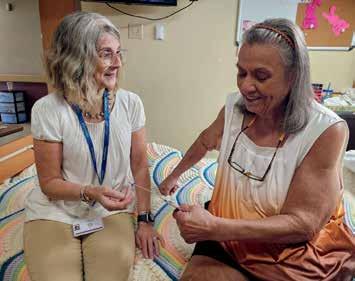







Café. Order the chicken salad.
Just before exiting the parkway for good at Route 52, which will take you back to the fast lane, stop at the Puckett Cabin. It’s a gray, weathered shack just like the ones that the German, Scottish and Welsh settlers built two centuries ago, when the parkway was just a path and the views were the
backdrop to daily chores.
Time spent on the parkway won’t make you a Southerner, not any more than having some chowder makes a Blue Ridge native a Yankee. But it’s a lovely way to see what their grandparents wanted to save, for them, and for us all: a view of the earth from halfway to heaven. n
• Check the National Park Service weather and condition reports for the parkway. Conditions change quickly, especially in spring and fall. The parkway is closed in the winter.
• Be sure your brakes work.
• Monitor your gas consumption carefully, as there are no gas stations on the parkway, nor are there signs to gas stations.
• Ditto coffee consumption, as the visitor centers
pop up only every 50 miles or so.
• To stay at the Peaks of Otter Lodge, make reservations well in advance at peaksofotter.com.
It’s best to book directly with the lodge to avoid confusion that arises when booking through third-party sites. The lodge offers updated rooms and strong Wi-Fi, which is nothing to take for granted given the almost nonexistent cell service on the parkway.






BY BRIANNA SNYDER
As we move through life, our wardrobes often become reflections of our experiences — filled with memories, but sometimes cluttered with pieces that no longer serve us.
Enter the capsule wardrobe, an increasingly popular approach to stocking your closet. Taissha G. “Tai” LaReau, a seasoned wardrobe consultant and personal stylist based in the Capital Region, describes a capsule wardrobe as “a number of pieces that can be mixed and matched over time.”
However, she emphasizes that it’s not about adhering to a strict number of clothing items. Instead, the focus is on curating “staple, versatile, timeless pieces that will work for you season over season, year over year.”
For many people over age 55, especially those transitioning into retirement, the idea of simplifying one’s wardrobe can be appealing or even crucial. Gone are the days of needing separate wardrobes for work and leisure. Now, the challenge is to create a clothing collection that suits a more flexible lifestyle while still looking polished and put-together. By having a well-coordinated collection of neutral colors and all-season pieces, you can create stylish outfits in under five minutes.
LaReau says it’s just this retirement lifestyle that poses a challenge for many of her clients over 50. They say, “I’m retired, I’m no longer working — I don’t know how to dress because I don’t want to look too formal.”
Her solution? Blend comfort with style. “Athleisure (athletic leisure wear) is so popular right now. That’s a really good place to start,” she says. The key is to combine comfortable pieces with more structured items. For instance, pairing pull-on pants with a blazer and nice loafers can create an outfit that’s stylish, comfortable and presentable. When building a capsule wardrobe, LaReau recommends focusing on neutral core colors like black, white, navy and gray. These shades form the foundation of your wardrobe, allowing for easy mixing and matching. But don’t worry — this doesn’t mean your wardrobe has to be dull. “If you want to add print and color, you can,” LaReau says. “You can still have so much fun.” This approach allows you to incorporate colorful pieces or experiment with new trends without overwhelming your wardrobe.
For those dealing with changes in body shape — another common experience as we age — a capsule wardrobe can be particularly helpful. LaReau emphasizes the importance of dressing for your current body, not the one you used to have or hope to have in the future. By focusing on well-fitting, adaptable pieces, you can feel confident and comfortable in your clothes, regardless of recent changes.
Quality should be a priority when building your capsule wardrobe. LaReau advises
investing in good fabrics, particularly for frequently worn items. This doesn’t necessarily mean designer labels — there are plenty of high-quality options available at various price points. By choosing well-made pieces, you ensure that your wardrobe will stand up to regular wear, maintaining a polished appearance.
Versatility is another key aspect of a successful capsule wardrobe. Look for pieces that can be dressed up or down depending on the occasion. A classic white button-down shirt, for example, can be paired with jeans for a casual lunch or worn under a blazer for a more formal event. This flexibility is particularly valuable for retirees, whose social calendars might include everything from casual meetups to elegant dinners.
And! A well-planned capsule wardrobe can make seasonal shifts seamless. LaReau emphasizes the importance of layering, suggesting lightweight sweaters, cardigans and blazers as essential transitional pieces. She also encourages rethinking traditional fashion rules, such as the notion that white is only for summer. This flexible approach to seasonal dressing can be liberating, allowing you to wear your favorite pieces year-round.
Regular wardrobe edits are crucial to maintaining an effective capsule wardrobe. LaReau recommends conducting
l Comfortable, well-fitting jeans
l Trousers (consider elastic waist for comfort)
l Classic white button-down shirt
l Lightweight cardigan sweater
l Blazer (for a polished look)
l Knee-length skirt or dress
l Comfortable, stylish flats or low-heeled shoes
l Neutral ankle boots
l Statement necklace or scarf
l Well-fitted undergarments
l Comfortable chinos or khakis
l Well-fitting jeans
l Button-up shirts (in both casual and dressier fabrics)
l Polo shirts
l V-neck or crew neck sweater
l Sports jacket or blazer
l Comfortable, stylish walking shoes
l Loafers
l Belt
l Classic watch

Focus on curating “staple, versatile, timeless pieces that will work for you season over season, year over year.”
— Taissha G. LaReau, wardrobe consultant and stylist
closet reviews every season to reassess your needs and identify any gaps. This practice not only helps keep your wardrobe current, but also prevents the accumulation of unused items — a common
issue for those who have been collecting clothes for decades. Ultimately, the goal of a capsule wardrobe is to create a collection of clothing that simplifies your life while allowing you to look and feel your best. n
l Layer wisely: Use lightweight cardigans, sweaters and jackets to adapt to changing temperatures without bulk.
l Invest in all-season fabrics: Choose materials like cotton, wool blends and breathable synthetics that work year-round.
l Embrace versatile pieces: Select items that can be worn across seasons, like a shirtdress that works with bare legs in summer or tights in winter.
l Accessorize for the season: Use scarves, hats and jewelry to update your look for different seasons without overhauling your wardrobe.

Peregrine Colonie
A Memory Care Community
5 South Family Drive, Colonie, NY 12205
Peregrine Clifton Park
A Memory Care Community 1 Emma Lane, Clifton Park, NY 12065
An Assisted Living & Memory Care Community
300 Mill Rose Court, Slingerlands, NY 12159
l Choose appropriate footwear: Invest in comfortable, supportive shoes that transition well between seasons, like loafers or ankle boots.
l Maintain a neutral base: Keep a foundation of timeless, neutral colors that work year-round, adding seasonal accents as desired.
l Regular wardrobe edits: Assess your closet each season to ensure all items still fit well and suit your lifestyle.
l Think in outfits: When adding new pieces, consider how they’ll work with your existing wardrobe across different seasons.

For More Information, Contact: Capitaldistrictperegrines@peregrine -companies.com ®
An Independent Living & Assisted Living Community 140 Washington Ext., Albany, NY 12203
An Assisted Living Community 467 Delaware Avenue, Delmar, NY 12054
An Assisted Living & Memory Care Community 345 Northern Blvd., Albany, NY 12204

A step-by-step plan for clearing out a lifetime of memories — and stuff
BY JENNIFER LARUE
When I was a kid, I felt kind of sorry for friends who, by virtue of their parents’ jobs or other circumstances, moved from house to house, city to city, state to state. My family was firmly rooted in the same home from the time I was 3 until my mother’s death last year, when I was 62, and I always appreciated the security that
came with having had the same family home forever. That sentiment extended to my adult life: Even decades after I’d actually lived there, the house held a wealth of memories, comfort — and stuff.
Ma lived there alone for the 30-plus years after my father died. But when COVID hit, my brother moved in with her. It soon be -





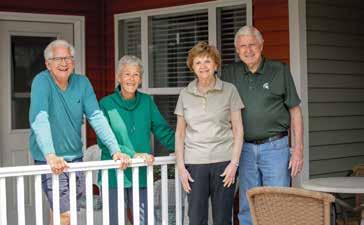

1 IDENTIFY A STAGING AREA. “When I walk into a house, the first thing I do is identify a place where we can place things we know we want to keep but don’t want to have in the way as we downsize,” Sable says. As you sort through the items, use different colors of painter’s tape — not sticky notes, which tend to fall off! — to mark items you want to go to each of your offspring, charity, the dump and so forth.
2 LIMIT YOURSELF TO THREE HOURS OF WORK in the house each day. “Everybody gets loopy after three hours,” Sable notes. “People get tired and make bad decisions.”
3 ADULT OFFSPRING SHOULD GET THE STUFF THEY WANT out of the
house ASAP. “This rarely happens,” Sable admits, “and it gets painful when the mom is saying, ‘Oh, my son really wants this,’ but the son makes no effort to come gather the item. Adult children say they don’t have a place to put the item or they’re too busy to come get it. But you’re adults. Figure it out!”
4 IDENTIFY THE BIGGEST “PAIN POINT” and start there. You’re eventually going to have to go through every box, bin, cabinet, shelf and drawer, Sable says, so tackling the most difficult decisions up front makes the whole process easier. When it comes to all those framed photos and other sentimental items, be sure to take your
came clear that she needed more care than he could provide, so we worked together to relocate her to a senior living facility near me. That’s when it hit me: We as a family had made no plans whatsoever for the eventual disposition of the family home.
Nearly two years after our mother’s death, my brother remains in the house; he recently bought out my share of the estimated sale price. There’s still a lot of stuff there, and the situation makes me wonder how much easier it might have been had our parents moved more frequently — or ever — and done a bit of downsizing and decluttering along the way.
“Those who are attached to everything they own find it painful to part with items.”
It also highlights for me the importance of talking as a family about the reality of preparing to one day say farewell to the family home.
—
time — even tell stories about them as you go.
5 DON’T COUNT ON AN ESTATE SALE to yield big bucks. “It’s very hard for people to swallow that their treasured items, particularly furniture, are not as valuable as they imagine,” Sable says. “If a client says, ‘It was my great grandmother’s,’ I tell them it owes them nothing more. At the end of the day, with an estate sale, you’re only going to make a few thousand dollars at best, and the sale just prolongs the agony.” Instead, Sable suggests donating as many items as possible to specific people, then, as painful as it may be, donating or tossing what’s left.
— Source: Sheilah Sable
process of parting ways with the homestead. Both companies offer a range of services for people who need help moving, downsizing, decluttering and even staging their homes for sale.
Sable says her clients who are downsizing include two categories of people: “those who are attached to everything they own and find it painful to part with items,” she says, and those who are “logical and rational, who can say, ‘I don’t really need this stuff.’
Sheilah Sable, moving concierge
Luckily (and not surprisingly), a whole profession has arisen around this phenomenon. People such as Sheilah Sable, of Albany-based Call Sheilah, and Michelle Kavanaugh-Anastasi of Organize Senior Moves in Glenmont, have crafted careers out of helping others navigate the emotional
“People in the second category are able to recognize that they are likely moving to the last place they’ll live and plan to take with them only the best of the best” of their possessions, Sable notes. Regardless of which category a client falls into, Sable approaches the task of clearing out a longtime dwelling with the same scheme in mind. She offers some top tips for achieving that goal (see sidebar).
In the end, there’s some comfort in knowing that we boomers are all in this together, right? And maybe, just maybe, we can find ways to make things easier for our own kids when it comes time to bid adieu to our own family homes. n
Age-old craft brewing tradition thrives in the Berkshires
BY TOM AND JERRY CARACCIOLI PHOTOS COURTESY OF INDIVIDUAL VENUES
If Cliff Clavin ever walked into one of today’s microbreweries he would no doubt pontificate on the “little-known fact” that the world’s first fermented beverages originated some 12,000 years ago. Beer, Clavin might’ve surmised, played a role in the rise of civilization itself!
Anthropologists theorize that the food staples of hunters and gatherers — wheat, rice, barley and maize — were the catalysts for their thirst for brewed beverages. Their taste for beer “lured our ancient ancestors out of their caves,” according to the Beer Institute, leading to the agricultural revolution and more sophisticated farming settlements. Cities grew from the innovations and eventually, the brew pub was born.
Barkeep, I’m ready for another!
In the United States, modern-day craft brewing began in the 1960s. Throughout the 1970s and ’80s, the proliferation of homebrewing led to the 1990s microbrewery explosion. Today, American





entrepreneur and billionaire businessman Charles James (Jim) Koch, co-founder and chairman of the Boston Beer Company, is widely recognized as the “founding father of the American craft brewing movement.”
Created from his great-grandfather Louis Koch’s beer recipe, Koch’s Samuel Adams Boston Lager became a staple at craft beer brew pubs in the 1990s for Americans looking for more taste than what was offered in mass-produced beverages. At the time, Koch had no idea that his first batch of Samuel Adams would launch a beer revolution that today boasts nearly 10,000 microbreweries, brewpubs, taproom brewers and regional craft breweries nationwide, according to the nonprofit Brewers Association.
In the Berkshires, craft beer and microbreweries are abundant. With more than 200 breweries dotting the landscape across the Commonwealth of Massachusetts, the Berkshires boast some 40 specialized makers that concoct their own brews.
“We brew a lot of beers that appeal to a wide variety of people,” said Christine Bump, head brewer at Big Elm Brewing in Sheffield. “This includes everything from a nice dark stout to hoppy IPAs, saisons and a couple different styles of lagers. We also have lower-alcohol beers because we don’t want to have anyone end up on the floor before or after a long bike ride or hike. We have one beer that is derived from ingredients all from the 413 area code (western Massachusetts). We try to use as much local materials as possible for our other beers.”
Jeff Egan, head brewer at Antimony Brewing in Lenox, added, “If you’re visiting, we tend to have something for anyone that’s into beer. We have blonde ale, lagers, IPAs, amber ale, sour beer, dark beer, stout, a huge range and there’s something for everybody. We also have a big menu of food, so it’s a no-brainer to go out, grab some food and have a beer. We’re centrally located in the county so it’s an easy destination for anyone.”
Some of the Berkshires microbreweries just east of the New York border include older establishments in business since the beginning of the microbrew craze and others that are newer but no less enthusiastic about providing interesting, quality craft beers.
Craft Brewery & Kitchen
55 Pittsfield Road, Lenox
Located in the heart of the Berkshires with Tanglewood nearby, Antimony Brewing offers a unique menu of craft beer and food in the newly renovated taproom. With a seven-barrel brew house visible from the taproom, Antimony crafts its beers on site. Live entertainment is offered weekly.







Brewery & Taproom
65 Silver St., Sheffield
In the true nature of the Berkshires, Big Elm Brewing not only offers craft beer from the 14-tap taproom, it also hosts events ranging from yoga and trivia to beer releases accompanied by food and music. Big Elm Brewing’s craft beers, including canned microbrews like 413, IPA American Lager and Gerry Dog Stout, are distributed in Massachusetts, New York, Rhode Island and Connecticut.
420 Stockbridge Road, Unit 4, Great Barrington
For 28 years, locals and visitors to Great Barrington have enjoyed this family-friendly, convenient craft brew restaurant. With solar-brewed beer — in growlers and 16-ounce cans available to go — Barrington Brewery & Restaurant also offers burgers, salads, scratch soups, desserts and more in their dog-friendly outdoor beer garden during the warmer months (only service dogs are allowed inside). Not far from Butternut Ski Resort, the inside of BB&R is a rustic hangout carefully pairing its beers with sourced American comfort food.
This Latina-owned brew pub in the heart of downtown Pittsfield is the dream come true of its owner and head brewer Sarah Real and co-founder and general manager Mike Dell’Aquila. Having deferred the dream for more than a decade, Real and Dell’Aquila overcame COVID hurdles and setbacks to open Hot Plate Brewing Co. in 2023. Having already been recognized with numerous awards for their craft beers with names like Handsome Sailor, Earth to Beer and Hop Riot, Hot Plate Brewing Co., with its seven-barrel brewery and attached taproom, also offers nine more varieties, as well as cans, growlers, non-alcoholic brews and beers to go.
The Wandering Star Craft Brewery is a self-distributing, 15-barrel production brewery and taproom that possesses a wide range of artisanal ales in kegs and cans. Distributing throughout Berkshire County, Wandering Star also is open on Saturdays and some holidays to accommodate tours, tastings, off-premise sales, as well as public and private events in a bucolic and homey atmosphere. n
















Saratoga Peanut Butter Company spreads joy with every spoonful
BY TRACI NEAL PHOTOS COURTESY SARATOGA PEANUT BUTTER COMPANY
You might have recognized the name and the familiar jar on your local grocery store shelves or at the farmers market.
Saratoga Peanut Butter Company got its start in 2005 inside a small kitchen in Saratoga Springs when local Jessica Arceri — a self-described “peanut butter freak” — realized she could market and sell some of the recipes she’d been creating for years to give away as gifts to family and friends.
Her son, Abe, whom she calls “the original Monkey Boy,” is the inspiration behind the banana-and-raisin peanut
butter that shares the name, one of her first concoctions. Since then, the company has expanded its flavor palate to include a variety of sweet — and even some savory — blends.
With about a dozen or so staples — ranging from Plain Jane to the spicy Slow Burner Garlic — Saratoga PB Company also whips up holiday-inspired and seasonal batches, like Pumpkin Pandemonium in the fall and Mistletoe (white chocolate peanut butter with cranberry and cinnamon) and Catch Me If You Can (gingerbread) in winter.
The company also sells a variety of
almond butter and almond-peanut blends. Keep an eye on Saratoga PB’s Instagram and Facebook pages and sign up for the monthly newsletter to get the latest updates, events and recipes.
Made in small batches, there’s no refined sugar, preservatives, palm oils or additives, only natural nuts and seeds, locally sourced honey and maple syrup, fresh spices, decadent dark and white chocolate and other add-ins.
As they prepare for their 20th year in business in February, the folks over at the company shared some favorite recipes for sweet and savory treats.



DePaul Housing Management 1-2 Bedroom Apartments and Cottages
ul Housing Management om Apartments and Cottages
INGREDIENTS:
• 3 tbsp. European salted butter, cut into small pieces
• ½ cup Pumpkin Pandemonium peanut butter
• 10 ounces Kraft Jet-Puffed marshmallows
• 5 cups Kellogg’s Rice Krispies cereal
• Sprinkle of pumpkin spice (optional)
DIRECTIONS:
1 Pour Rice Krispies cereal into a large bowl and set aside.
5 Counties -15 Communities: Albany, Delaware, Rensselaer, Saratoga, and Schenectady
DePaul Housing Management 1-2 Bedroom Apartments and Cottages
n Fully Accessible with Elevators
n Community Computers w/ Internet
n Affordable Rents Based on Income
5 Counties -15 Communities: Albany, Delaware, Rensselaer, Saratoga, and Schenectady
nties -15 Communities: Rensselaer, Saratoga, and Schenectady
n Smoke-Free Communities
2 In a large saucepan, melt the butter over low heat, being careful not to burn. Once the butter is melted, add the peanut butter to the saucepan and stir.
n Pet Friendly
• Fully Accessible with Elevators
n Health and Wellness Programs AND SO MUCH MORE!
• Affordable Rents Based on Income
• Pet Friendly
Accessible with Elevators able Rents Based on Income riendly munity Computers w/ Internet Smoke-Free Communities
We Have Something for Everyone - Apply Today!!
• Community Computers w/ Internet
10 Carondelet Drive, Watervliet, NY 12189 518-389-6335
• Smoke-Free Communities
• www.depaulhousing.com

3 Once the peanut butter and butter are combined, add the marshmallows, stirring constantly. When the marshmallows have melted and the mixture is combined, remove pan from heat and pour over Rice Krispies cereal. Stir all of the ingredients together carefully.
• Health and Wellness Programs And So Much More!
NYS TTY #711 YOUR NEW ADVENTURE AWAITS YOU!
We Have Something for Everyone - Apply Today!!
Licensed Agency Providing Quality In-Home Aide Services since 1985 for 11 Counties

Care
• Keep your loved one in the comfort of their own home & familiar environment with a reliable and personalized certified aide.
• Hourly shifts or our specialty of 24/7 uninterrupted live-in care options are available.
• Continuity of care is arranged and staffed by our nursing supervisors.
• Our agency is committed to providing quality service in a professional manner.
4 Pour ingredients from the bowl into an 8x10 pan that has been oiled. Chill in the refrigerator for an hour. Cut into portions and enjoy!
INGREDIENTS:
• 3 tbsp. Slow Burner peanut butter
• 3 tbsp. unseasoned rice vinegar
• 1 tbsp. fresh lime juice
• 3 tbsp. avocado oil or other oil
• 3 tbsp. honey
• 1 tbsp. sugar
• 1-2 cloves minced garlic
• ½ tsp. sesame oil
• dash of salt to taste
DIRECTIONS:
1 Thoroughly mix all ingredients together in one bowl. Add a dash of Sriracha if you would like more heat! This sauce works great as a marinade on chicken/tofu, as a sauce for a Thai-inspired dish, or a simple salad dressing with edamame added for extra protein.
INGREDIENTS:
• 1 cup Blizzard peanut butter
• ½ cup melted coconut oil
• 2 tbsp. maple syrup
• 2 tsp. vanilla
• White chocolate chips (optional)
DIRECTIONS:
1 Mix all ingredients together and pour into a brownie pan. Sprinkle white chocolate chips if desired.
2 Freeze for at least one hour. Enjoy!
INGREDIENTS:
• 1 cup old-fashioned oats
• ½ cup Adirondack Jack
• 1 tsp. vanilla extract
• ⅔ cup toasted shredded coconut (optional)
• ½ cup chocolate chips (optional)
DIRECTIONS:
1 Stir all ingredients together in a large bowl until combined. Cover and chill for one to two hours, then roll into 1-inch balls.
2 Enjoy immediately, refrigerate in a sealed container for up to one week or freeze for up to three months.

IF YOU’RE LOOKING FOR A LITTLE MORE PUNCH in your peanut butter, take a look at some of Saratoga PB Company’s more adventurous blends!
• Slow Burner: Peanut butter with Sriracha and garlic powder that tastes great on everything from Asian dishes to burgers.
• Adirondack Jack: Trail mix in a jar! A
blend of almond and peanut butters, red cranberries, flaxseeds, sunflower seeds, a drizzle of wildflower honey and a sprinkle of cinnamon.
• Adirondack Jill: A blend of almond and peanut butters, blueberries, pepitas, a drizzle of wildflower honey, chia seeds, cinnamon and pure vanilla.
• Trifecta: A tribute to Saratoga Springs,
featuring dark chocolate, almond butter and cherries.
• Blizzard Butter: A creamy white chocolate and vanilla blend that tastes great with apples, on sandwiches or by the spoonful.
• Hey Babe: California almonds with a touch of white chocolate and dried blueberries.

BY JANET REYNOLDS
We all read books for different reasons. Sometimes we just need to escape the world. Other times we are motivated to learn something new. This column’s recently published books — two fiction and one nonfiction — allow us to do both.
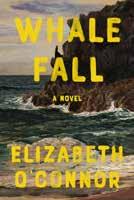
by Elizabeth O’Connor, Pantheon, 224 pages, $27
When a whale dies at sea and its carcass falls to the sea floor — a phenomenon called a whale fall — it becomes a thriving ecosystem for deep-sea creatures, providing food and other resources. In Elizabeth O’Connor’s new novel, the dead whale is washed ashore on a remote Welsh island rather than falling to the ocean’s depths. There, it is a curiosity and feels more like an ominous portent than a resource.
Set in 1938, the novel follows 15 families living rugged lives as they grab what they can from the waters that surround them and make do. News from the mainland arrives in dribs and drabs, often days or months after the fact. There’s a “Big War” brewing, but no one fully knows what’s happening. The future feels as uncertain as the weather on the island.
Enter two English ethnographers who hope to study island culture. They ingratiate themselves among the fisherfolk with
a particular focus on Manod, the 18-year-old narrator. She’s bright, speaks both English and Welsh (unusual for those on the island) and has aspirations. What kind of life could she have if she left?
The couple’s true intent, however, quickly becomes clear. While they initially appear to want to celebrate this fading lifestyle and culture, to record it for posterity, their real purpose is more about them than the people they’re recording and whose stories they’re telling. The result is a story about loss and finding oneself, both in community and as an individual. It’s a story that is at once lyrical, poignant and gripping.

by
The Alternatives follows the four Flattery sisters as they navigate their complicated lives in an increasingly complicated world. Olwen, the eldest and a geology professor, kicks off the story by deliberately disappearing one night on her bicycle. She’s found a few months later by sister Rhona, a political science professor at Trinity College in Dublin. She notifies the other two sisters, Maeve and Nell, who return to their Irish homeland to try to
out what the heck is going on with their sister and, by extension, themselves.
Maeve is an Instagram-famous chef and cookbook author who is obsessed with food shortages and wants her next cookbook to focus on that idea. (Her publisher is decidedly less than thrilled.) Nell is an adjunct professor in Connecticut who has a mysterious ailment that makes movement challenging — except when she does her regular nocturnal swims in oceans and ponds.
As orphans whose parents wandered off a cliff on a stormy Irish night when they were children, they are all understandably damaged in their own ways and a little unsure of how to actually interact as adults. They are also each grappling with living in a world where the climate and environment are in danger, and struggling to address it in their own ways. Their story in that sense is our story — a tale of family love and strife and how we all come to terms with our duty to each other and the world outside our collective doors.

by
Mo Rocca and Jonathan Greenberg, Simon & Schuster, 372 pages, $28.99
Mo Rocca is no stranger to death and, by extension, aging. While many may know Rocca as a regular on NPR’s Wait Wait … Don’t Tell Me! and CBS News Sunday Morning, he’s also the host of the podcast Mobituaries. In the podcast, which begins its fourth season this fall and inspired the bestselling book of the same name, Rocca explores people and things that are gone but should not be forgotten.
In this new book, Rocca and co-author Jonathan Greenberg expand on that idea by focusing on people whose big moments came late in life. Some are still alive. Others are gone. All of them are fascinating as Rocca explores his underlying premise that 80 is the new 60.
Whether you agree with that assertion doesn’t really matter. The stories are heartwarming, fascinating, and a walk down memory lane for those of us of a certain age (in other words, you). We learn the story of Estelle Getty, who was 62 when she finally got her big break as an actress after first starring on Broadway in Torch Song Trilogy and then being chosen to play the always-entertaining Sophia Petrillo on The Golden Girls. Laura Ingalls Wilder, meanwhile, author of the perennially favorite Little House series, began publishing at the age of 65. The list goes on and is filled with stories written in Rocca’s chatty style.
Simply put, this book is a delight and a reminder that aging is never an excuse to give up on your dreams. n





BY ROD MICHAEL
As a longtime gardener, I know that the effort I put in is directly related to the reward. Like our lives, we must fertilize our soil and our minds, we must keep the plants — and our bodies — hydrated, and without a doubt we must keep the weeds — those negative thoughts that cripple us — out.
Garlic is a great example to follow. By planting the clove at the correct time in the fall so it can go through its vernalization process over the winter, it becomes ready when the warm rays of spring hit the earth and the clove begins its upward journey. It then grows a scape and flowers; the scape is quite delicious and must be cut off. If not stopped, it will rob all the energy from the garlic head that’s forming. Much like us, if we go off on a tangent, we will rob ourselves of future growth. We must stay focused on growth so we can reach our full potential.
To grow as a person, it helps to identify our values and what gives us meaning and purpose. To grow as a person, we must practice gratitude and reflection, set short- and longterm goals and push ourselves, much like the garlic, upward to reach them. Like the garlic, be resilient, adapt to change, manage stress and keep a positive attitude. Always believe in yourself, learn something new and be productive. Focus on the positive, think about the parts of your life that work well and remember the skills you used to navigate the challenges.
Life does not throw problems at us, it gives us lessons. Sometimes we learn and sometimes the lesson comes back at us in a different form. Our growth, much like the garlic, is not an option, it is part of being human.
As we enter the fall season, I encourage you to keep the idea of garlic in the back of your mind. Be ready when those warm rays of spring arrive to continue your journey of upward growth.
In the words of the song by Derek and the Dominos, Eric Clapton sings, “She said, you’re gonna be alright boy, oh just as long as you keep on growing, keep on growing, keep on growing, Yeah! Yeah! Yeah!” n





For those who desire 55+ living to be anything but ordinary, we present Mosaic. With 146 exceptional residences and premier amenities coming to culturally rich Lancaster, PA, Mosaic will o er the very best in active adult living.
LANCASTER, PA
A TOP PLACE TO RETIRE U.S. News & World Report
And because Mosaic is by awardwinning Willow Valley Communities, you’ll be part of an engaging community with a 40-year national reputation for excellence. Plus, the

peace of mind of our Type A Lifecare, so while you live life fully today, you have a scally wise plan in place for tomorrow.
Apartment selections are underway at pre-construction pricing. To learn more, contact our Mosaic Residence Advisor, Barb Bidding at 888.893.1423 or by email at bbidding@willowvalley.org.

mosaiclancaster.com 888.893.1423




Embrace Fall’s Splendor with Champlain Area Trails!
Immerse yourself in vibrant foliage and crisp air. Our diverse trails, perfect for all skill levels, offer stunning fall views. Lace up your boots and capture the season’s splendor—your autumn adventure begins now!

SCAN TO START PLANNING